Preprint
Article
Techno-economic Feasibility Study of a 1.5 MW Grid-connected Solar Power Plant in Bangladesh
Altmetrics
Downloads
311
Views
66
Comments
0
A peer-reviewed article of this preprint also exists.
Submitted:
17 October 2023
Posted:
18 October 2023
You are already at the latest version
Alerts
Abstract
This study addresses the pressing energy constraints in nations like Bangladesh by proposing the implementation of photovoltaic (PV) microgrids. Given concerns about environmental degrada-tion, limited fossil fuel reserves, and volatile product costs, renewable energy sources are gaining momentum globally. Our research focuses on a grid-connected solar PV system model at Char Jazira, Lalpur, Natore, Rajshahi, Bangladesh. Through PVsyst simulation software, we assess the performance ratio (PR) and system losses, revealing an annual solar energy potential of 3375 MWh at Standard Test Condition (STC) efficiency. After considering losses, the system generates 2815 MWh annually, with 2774 MWh exported to the grid. We analyze an average PR of 78.63% and calculate a levelized cost of energy (LCOE) of 2.82 BDT/kWh [1 USD = 110 BDT]. The financial assessment indicates a cost-effective LCOE for the grid-connected PV system, with an annual gross income of 27744 BDT from selling energy to the grid and operating costs of 64060.60 BDT/year. Remarkably, this initiative can prevent 33074.061 tCO2 emissions over the project’s 25-year lifespan.
Keywords:
Subject: Engineering - Electrical and Electronic Engineering
1. Introduction
In Bangladesh, fossil fuels presently dominate energy production, accounting for 99% of the total [1]. However, the country has established challenging renewable energy targets for 2030 and 2040, mandating major time and financial commitments [1]. In order to accomplish these goals, solar energy is poised to be extremely important [1]. As the world actively seeks sustainable energy solutions, solar power has emerged as a prominent player [2]. Grid-connected solar power plants are a focus of efforts worldwide to cut carbon emissions and switch to cleaner electricity sources since they can capture a lot of sunshine with little harm to the environment [3,4].
This study’s main goal is to evaluate the feasibility of building a 1.5 MW solar power plant in Lalpur, Natore, Bangladesh, while taking into account its integration with the current grid system. The evaluation utilizes the robust simulation capabilities of the PVsyst program. Notably, Bangladesh experiences an average annual increase in energy demand of 4.68%, attributed to a burgeoning population and an improving economy [1]. Like many nations, Bangladesh faces the dual challenge of meeting escalating energy demands while mitigating greenhouse gas emissions [5]. Interest in the development of solar power has increased as a result of the country’s adherence to the Paris Agreement and desire to increase the proportion of renewable energy in its energy mix [6]. Given Bangladesh’s abundant solar irradiance, there is a significant opportunity to harness solar energy, bolstering the nation’s energy security and aligning with its environmental objectives [7].
A thorough techno-economic feasibility analysis is essential before moving forward with the development of a solar power plant. These analyses provide a complete evaluation of the viability of the proposed project, taking into account technical, economic, and environmental factors [8,9]. By evaluating both the technical and economic aspects, decision-makers can make well-informed choices regarding project implementation. Additionally, techno-economic analyses shed light on potential risks, challenges, and opportunities associated with the project. A study at Pakistan’s Islamia University in Bahawalpur advocates for the installation of a grid-connected PV system, emphasizing its effectiveness and ecological benefits [10]. This solar-powered system produces 4908 MWh each year, which is comparable to 147600 teak trees planted during a lifetime or 15369.3 kg of coal saved per day. The study’s objective is to assist with the creation, evaluation, implementation, and upkeep of new grid-connected systems across numerous places [10]. Afghanistan faces a challenging energy situation, relying on electricity imports and incurring significant costs [11]. To address this, the government plans to generate 5,000 MW of renewable energy by 2032, with a focus on 1,500 MW of solar projects. Afghanistan’s Daikundi province offers the best sunlight for solar energy production, as shown by a 700KWp grid-connected solar power plant that was tested using the PVsyst program [11]. The effectiveness of a standalone solar PV system in relation to the load requirements at the mechanical department office at Bikaner Engineering College is the subject of another study [12]. The study reveals an average yearly energy need of 1086.24 kWh, with the solar panel providing 1143.6 KWh. Multiple losses contributed to the system’s reduced power capacity, with variations in performance ratio throughout the year [12].
In another research study [13], the viability of a 200 KWp on-grid monocrystalline silicon solar project in Dubai was assessed using the PVsyst program. The system exhibited an impressive yearly performance ratio of 81.67%. From its 32 parallel strings and 22 series modules, the solar facility generated 352.6 MWh annually, achieving an energy output of 1757 kWh/KWp per year. This study further offers detailed loss estimates for the entire year, providing valuable insights into the system’s performance [13]. An article focuses on the viability of a solar PV plant in Pune, India, utilizing a 250 KWp Si-poly photovoltaic facility as the subject [14]. In order to model the plant, which consisted of 310 Wp modules coupled to 65 strings and 42 string inverters, the study used PVsyst 7.2 software and Meteonorm 8.0 data. Several tests were carried out to establish the best angle for power generation, taking into account things like incidence radiation, performance ratio, and grid input energy [14]. Additionally, a study uses PVsyst software to analyze a 20MW grid-connected solar facility in Devdurga, Karnataka, India [15]. The analysis provides insights into performance trajectories and geographical positioning, predicting a 110-acre area with a remarkable 76.28% performance ratio. The study also examines the system’s behavior concerning tilt and orientation, further enriching our understanding of solar plant dynamics [15].
In a notable study [16], the Grid Connected Photovoltaic Array System, which is intended to produce 15kWp at STC, was the main focus. The study carefully looked into a number of factors, including system output, output power losses, performance ratio, output energy, PV module output, field type adjustment, power distribution curves, temperature distribution, and module connection in string design. Furthermore, a research effort involved the design and simulation of a 60 KWp solar power plant for a rural area in Uttar Pradesh, India, utilizing PVsyst software version 7.2.2. The analysis considered seasonal tilt angles and conducted a comprehensive performance study [17]. A separate research paper [18] delved into a study of a 1 MW photovoltaic plant located in Morocco’s northern zone. The study utilized PVsyst software to evaluate the plant’s performance, making comparisons among solar energy production at different sites. This study underscored the critical need for accurate predictions of system efficiency in renewable energy systems. PVsyst simulation software was employed in yet another study [19], where the main goal was to build and simulate a hybrid photovoltaic system for a system of energy-efficient street lighting. The system comprised 16 Narada batteries, 13 series-connected modules, and 4 parallel strings. The modeling showed a yearly energy output of 26.68 MWh overall and an annual energy production of 1283 kWh/KWp specifically. Notably, the study highlighted performance ratios and battery cycle conditions, providing valuable insights into system behavior. In a different research endeavor [20], a 5 MW solar power project in Afghanistan’s Ghor region was planned and simulated. The plant incorporated a 5300 kW Growatt converter type and 6399 KWp STP-320 W PV module. Various modeling tools, including PVsyst, PVGIS, and HOMER, were utilized to evaluate solar renewable energy sources. The findings showcased annual energy generation variations among the modeling tools, emphasizing the importance of accurate simulation for efficient planning.
Despite the existing studies utilizing PVsyst and exploring solar power plant designs and financial aspects, there is a research gap in conducting a comprehensive analysis encompassing detailed losses, financial analysis, cost-effectiveness, and carbon balance collectively. Additionally, previous works have not sufficiently addressed potential challenges, risks, and mitigation strategies associated with the implementation of solar power plants. Our study bridges these research gaps by providing a comprehensive techno-economic feasibility assessment of the proposed solar power plant. We contribute to the field by integrating detailed loss analysis, financial evaluations, cost-effectiveness assessment, carbon balance considerations, and a thorough examination of potential challenges and mitigation strategies. Our structured approach facilitates a holistic understanding of the project’s viability, making a meaningful contribution to the advancement of sustainable energy solutions.
In this present study, to model the operation of a 1.5 MW grid-connected solar power plant in Lalpur, Natore, we have used the potent PVsyst program. PVsyst is highly esteemed for its capacity to model PV systems under varying conditions encompassing solar irradiance, temperature, shading, and system configuration [21]. The software enables accurate predictions of energy generation, performance ratios, and financial metrics, rendering it an invaluable tool in the feasibility assessment of solar projects [22]. However, a collective and detailed analysis, including losses, financial aspects, cost-effectiveness with a simple payback period, and carbon balance, has not been previously conducted in the mentioned research and studies.
We intend to develop the solar power plant layout after assessing the project site’s solar resource potential and climate. Important aspects to take into account are panel orientation, tilt angle, and shading analysis [23,24]. With the aid of the PVsyst program, we intend to simulate the energy generation profile of the solar power plant under various conditions. This simulation will help estimate key financial metrics such as the LCOE, payback period, and ROI, enabling a comprehensive assessment of the project’s economic viability [12]. Additionally, we want to pinpoint any obstacles, dangers, and suitable countermeasures related to the construction of the solar power plant [25].
This study is divided into several sections, each of which deals with a different component of the techno-economic feasibility assessment. These sections include an evaluation of the solar resource, plant design and simulation, financial analysis, and a discussion of findings [26,27]. Through this structured approach, we aim to attain a comprehensive understanding of the project’s viability and potential benefits, empowering informed decision-making in the pursuit of sustainable energy solutions.
2. Location and Data
2.1. Project Site Selection
The chosen project site is located in Lalpur, Natore, Rajshahi, Bangladesh, specifically known as Char Jazira. The geographical coordinates for this location are 24.0900°N latitude, 88.5800°E longitude, and an altitude of 22 meters above sea level. The time zone in this region is UTC+6. In Bangladesh, a ‘char’ typically denotes a riverine island or sandbar that forms within the braided river systems, shaped by the dynamics of sedimentation and erosion in the river. The specific location for this project, Char Jazira, fits this description. Char Jazira is positioned in the floodplains of the Jamuna River, a major river in Bangladesh. The land is state-owned, and due to its nature as a riverine island, it is devoid of tree shadows, making it ideal for a solar project. The incident solar irradiation in this area is notably high.
The average annual rainfall in Lalpur, Natore, Bangladesh is 2,200 millimeters (86.6 inches). The wettest months are June, July, and August, receiving an average rainfall of 300 millimeters (11.8 inches) each. On the other hand, the driest months, namely December, January, and February, witness an average rainfall of 50 millimeters (2.0 inches) each. Lalpur in Natore, Bangladesh observes the lowest rainfall during these months.
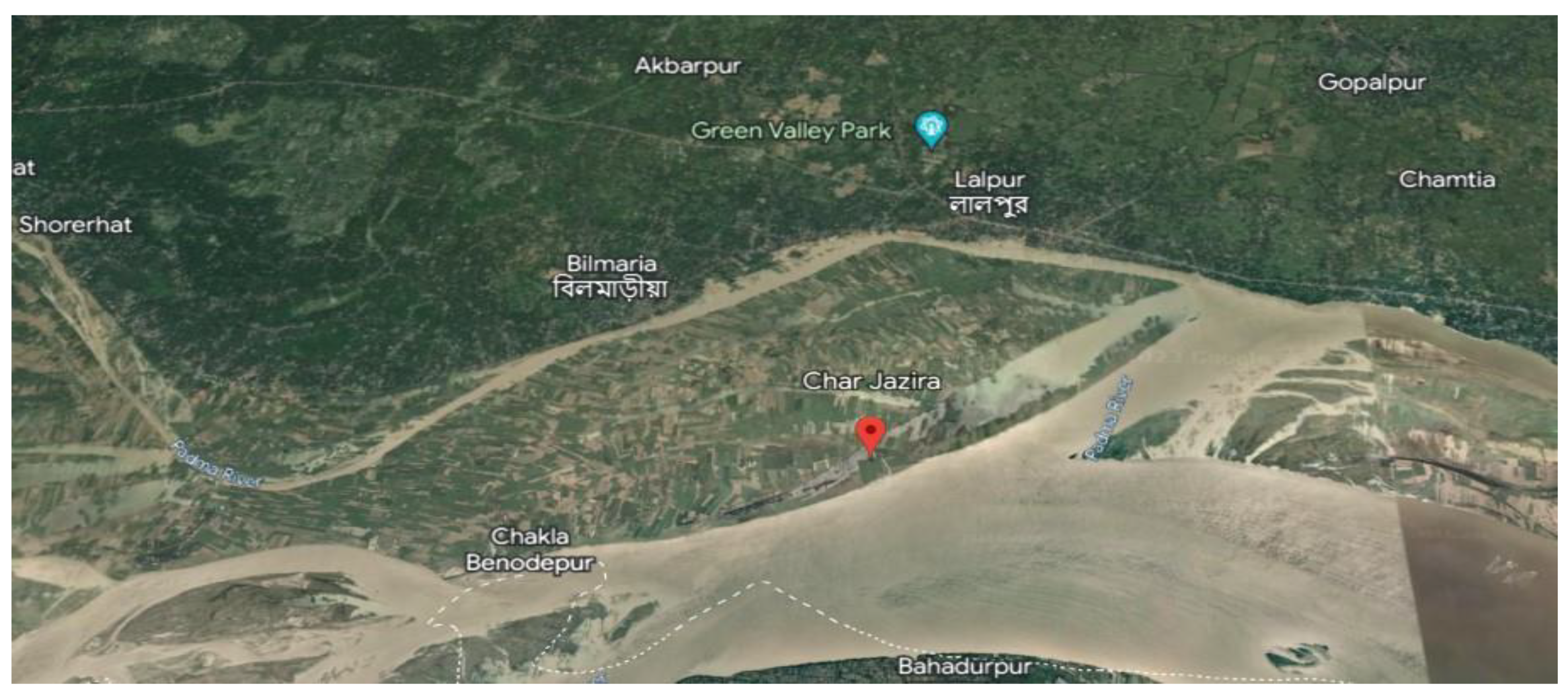

Figure 1.
Pinned location of Char Jazira, Lalpur from Google Earth.

Figure 2.
Red colour marked area - Location of Char Jazira, Lalpur from Google Maps.

2.2. Meteorological Data
PVsyst software relies primarily on solar irradiance data for accurate modeling of solar photovoltaic (PV) systems. In addition to solar irradiance data, meteorological data is also incorporated to enhance the precision of system modeling [28,29,30]. The following are key meteorological parameters needed for software simulation of the solar power plant:
1. Solar Irradiance:
Solar irradiance data is essential for PVsyst software to compute a PV system’s energy production accurately. This data includes:
- Global Horizontal Irradiance (GHI): Total solar energy, including both direct and diffuse solar radiation, that is received on a horizontal portion of the Earth’s surface. GHI, which is measured in watts per square meter (W/m2), is an important aspect to consider when assessing the solar energy potential of a site [29,31].
- Direct Normal Irradiance (DNI): Solar radiation that strikes a surface perpendicular to the sun’s rays. DNI is the amount of sunlight that enters the Earth straight from the sun, unaffected by air absorption or scattering. It is essential for applications and concentrated solar power (CSP) systems that need direct sunshine. Watts per square meter (W/m2) are commonly used to measure DNI.
- Diffuse Horizontal Irradiance (DHI): Aside from direct sunlight, solar radiation that is received from the sky. DHI is made up of solar energy that is reflected or dispersed and diffusely reaches the surface of the Earth. It is crucial for solar energy applications since it measures on a horizontal surface, especially for PV systems that may take in both direct and diffuse sunlight. DHI can also be calculated in W/m2.
Understanding and utilizing these meteorological parameters in the PVsyst software is crucial for precise modeling and assessment of solar energy systems.
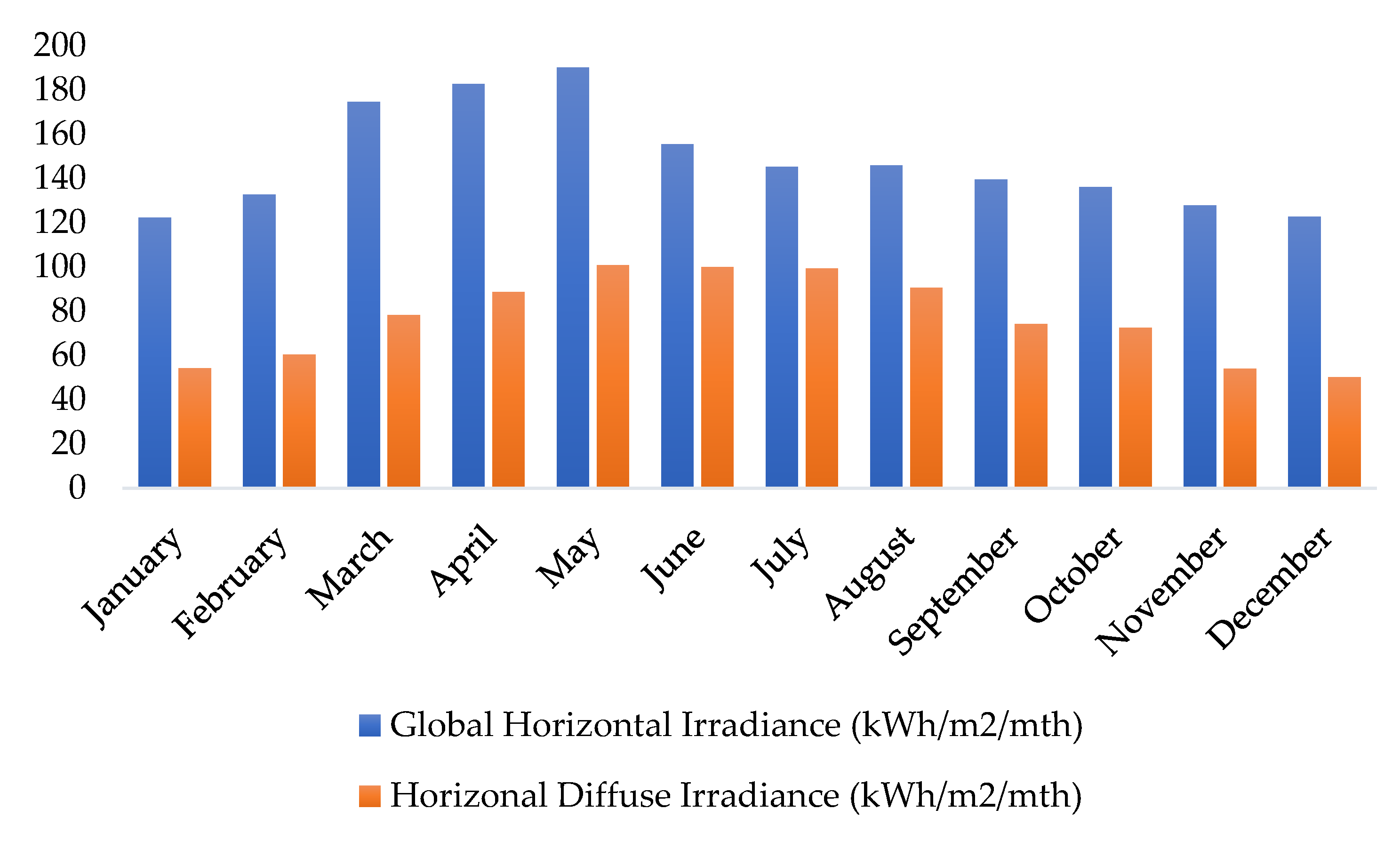
Figure 3.
Solar irradiance.

2. Temperature
The performance of PV modules is greatly influenced by the ambient temperature. Temperature information is necessary for PVsyst software to accurately analyse the attributes of PV modules. The electrical characteristics of the PV modules can be determined with the use of this temperature data. In actuality, hot, bright days with little breeze tend to have higher operating temperatures for PV modules. A PV module’s temperature is predicted by the Nominal Operating Cell Temperature (NOCT), a standardized rating system, under a variety of parameters, such as 20°C ambient temperature, 800 W/m2 of solar energy, and 1 m/s of wind speed. It is essential to comprehend a PV module’s temperature because it has a significant impact on its electrical properties.
A detrimental effect of temperature rise on a PV module’s efficiency. The energy band gap of the semiconductor material narrows with temperature, requiring less energy to produce a free electron-hole pair, which results in the decrease in efficiency. As a result, a PV module’s power production decreases as temperature increases. The temperature coefficient of power (Pmax), which is often stated as a percentage per degree Celsius (°C), measures this decrease in power output caused by an increase in temperature. Understanding how temperature changes effect a PV module’s performance requires an understanding of the temperature coefficient of power.
3. Wind Velocity
Wind velocity, or wind speed, significantly influences the performance of PV modules by affecting their operating temperature and cooling mechanisms. Accurate wind speed data is crucial for the PVsyst software to estimate the cooling effect on module performance and simulate its impact on energy production. Wind speed plays a beneficial role in solar power generation from panels. It aids in cooling the solar panels, consequently improving their efficiency. As solar panels get hotter, their efficiency tends to decrease. Wind helps dissipate this heat, maintaining or even enhancing the panel’s performance. Wind also aids in removing dirt and debris from solar panels’ surfaces, increasing their effectiveness. The electricity production of solar panels can increase by up to 20% when there is wind. The precise rise, however, relies on a number of variables, including the surrounding temperature, sun irradiation, and the type of solar panel being utilized. In general, higher wind speeds cause solar power generation to rise more quickly. The rise in power production does level off at a certain point, though. This is because the cooling effect of wind becomes less significant as wind velocity continues to increase.
Understanding and incorporating wind speed data into simulations are critical for accurately assessing the impact of wind on solar panel efficiency and optimizing solar power generation.

Figure 4.
Temperature and wind velocity.

4. Linke Turbidity
In the context of solar energy modeling, the Linke Turbidity Coefficient serves as an atmospheric parameter that provides insights into water vapor concentrations and aerosols. While the clear sky model primarily uses location coordinates (latitude, longitude, and altitude), the Linke Turbidity Coefficient can introduce slight alterations. This coefficient typically ranges from 2.0, indicating a very dry and clear sky, to 5 or 6, indicating a humid and potentially polluted environment. A common default value used for many sites is 3.5 [32,33]. Turbidity, in a broader sense, characterizes the cloudiness or haziness of a liquid caused by numerous small suspended particles, including dust, sediment, organic materials, and plankton in water. Turbidity has a considerable impact on the amount and distribution of solar radiation that reaches solar PV panels or solar thermal collectors in the field of solar energy production.
Turbidity in the atmosphere can absorb and scatter light, reducing the amount of direct and diffuse solar irradiance that reaches solar panels. This decrease in solar irradiance ultimately diminishes the overall energy output of PV panels. Turbidity’s impact is evident in the scattering of sunlight, potentially increasing the diffuse solar radiation component while decreasing direct solar radiation due to scattering. Certain solar energy systems, particularly those adepts at capturing diffuse sunlight effectively, can benefit from this shift. Additionally, turbidity may appear as debris, dust, or dirt adhering to the PV panel’s surface. The buildup of these particles reduces direct sunlight’s ability to reach the solar cells, which has an impact on the PV system’s effectiveness and power generation. The performance of solar panels must be maximized, which means keeping them clean and removing as few of these impediments as possible.
5. Relative Humidity:
A measurement known as relative humidity (RH) expresses the amount of moisture in the air in relation to the maximum amount of moisture the air may contain at a specific temperature. Its relevance for solar radiation and PV panel efficiency—two important factors impacting solar power generation—is stated as a percentage. PV module temperature and efficiency are both significantly influenced by relative humidity. It has an impact on the module’s electrical properties, which may therefore have an impact on energy output. The software’s ability to correctly assess these effects depends on accurate input of relative humidity data.
In terms of solar radiation, relative humidity directly affects the amount of direct and diffuse solar radiation reaching solar panels. Cloud cover and a rise in atmospheric water vapor are frequently correlated with higher relative humidity. Clouds can reflect and absorb sunlight, reducing the amount of direct solar irradiance that reaches solar panels and, as a result, reducing energy output. Elevated relative humidity levels, often associated with increased cloud cover, lead to a higher proportion of diffuse solar radiation. Despite the reduction in direct sunlight due to cloud cover, diffuse radiation still contributes to the overall energy production of solar panels.
Relative humidity is closely intertwined with temperature. As temperature increases, the air can retain more moisture, resulting in lower relative humidity for the same absolute moisture content. High temperatures, usually linked with low relative humidity, can enhance PV panel efficiency by reducing resistive losses within the solar cells. Regions with high moisture content or coastal areas, often characterized by higher humidity levels, can experience dust and dirt accumulation on solar panels. Regular cleaning and maintenance of solar panels are crucial to ensure that accumulated dirt does not obstruct sunlight absorption and impact energy production. Keeping the panels clean optimizes their performance and, in turn, the overall solar power generation efficiency.

Figure 5.
Linke turbidity and relative humidity.

2.3. Sun Paths Diagram
Sun path analysis is crucial for determining the solar irradiation and shading conditions at a specific location over a given period. PVsyst makes use of solar geometry computations to determine the sun’s position with relation to the site and time of interest. It precisely determines the sun’s position throughout the year by taking into account variables like latitude, longitude, time zone, and date. The software can generate detailed graphical representations of the sun’s path, including azimuth and sun height angles [34]. This graphic of solar paths shows the sun’s daily position in the sky as well as the seasons. PVsyst assists users in assessing the effects of shadowing, figuring out the best tilt and orientation for solar panels, and analysing the overall solar energy potential at a particular site by visualizing the sun’s path [35].
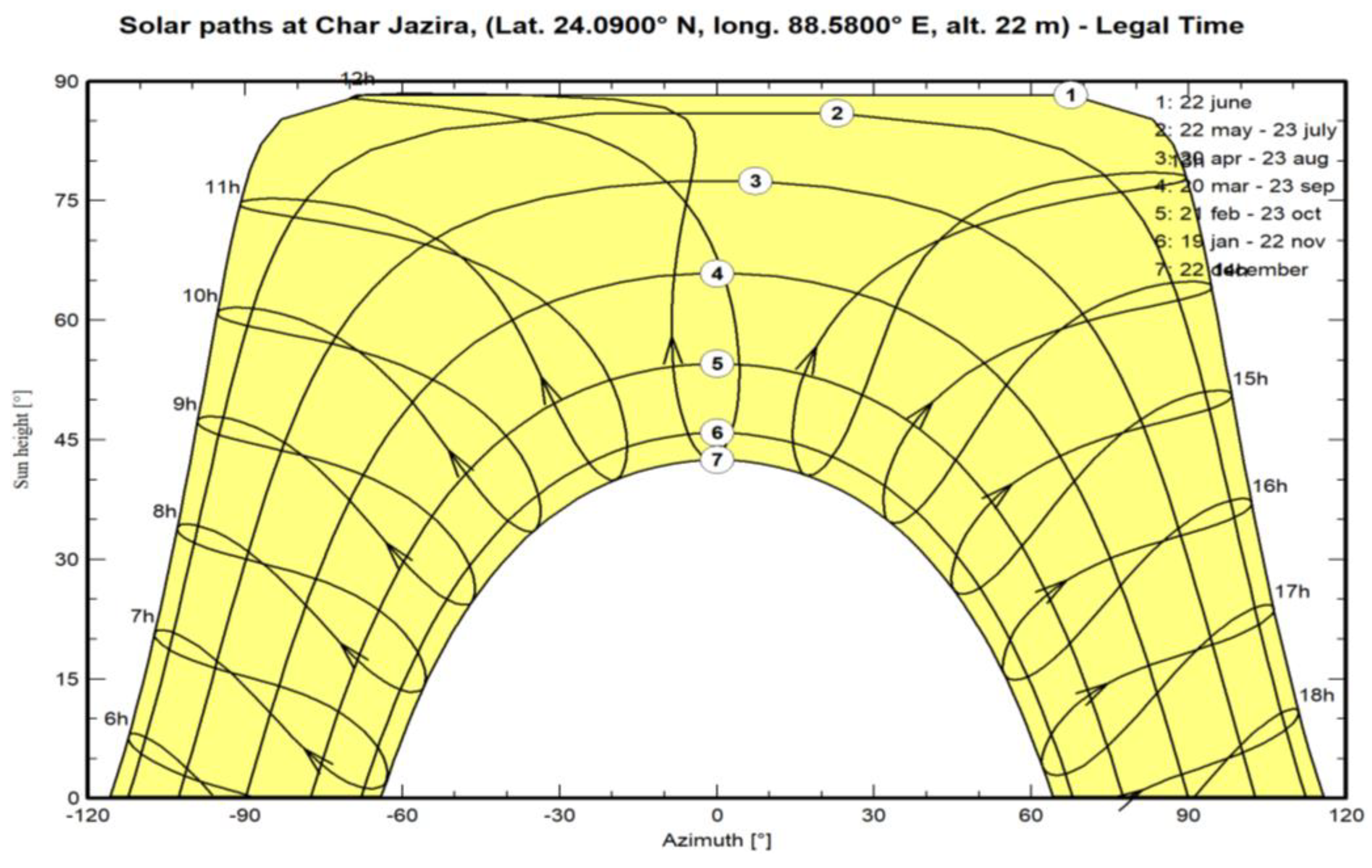
Figure 6.
Sun paths diagram in legal time and rectangular coordinate.

3. Methodology
Site assessment: An important stage in guaranteeing the success of a solar project is to carry out an on-site assessment of the solar plant location in Lalpur, Natore to obtain information on solar irradiance, shading analyses, weather patterns, and topographical factors. This information is essential for precisely estimating the region’s solar potential and adjusting the layout and positioning of solar panels to increase their effectiveness and sustainability. Additionally, the evaluation will help in identifying potential challenges or limitations associated with the location that may need to be addressed during the planning and implementation phases of the solar project.
Resource data collection: Gathering historical solar irradiance and meteorological data for the region to accurately model the plant’s performance is essential for designing and operating a reliable and efficient solar power plant.
PVsyst simulation: Utilization of PVsyst software for system design and simulation is paramount. Input collected data to simulate the solar power plant’s energy production, considering various factors like module type, array layout, inverter specifications, and system losses allows for a precise and detailed projection of the plant’s potential output. This simulation aids in optimizing the solar power system’s configuration, ensuring it is tailored to the specific conditions of the Lalpur, Natore location and can operate at peak efficiency, thus maximizing energy generation and overall performance.
Performance evaluation: Analysis of the PVsyst results is crucial to assess the plant’s annual energy yield, capacity factor, and performance ratio, considering local climatic conditions and system parameters. This evaluation provides valuable insights into the solar power plant’s overall efficiency and productivity, allowing for informed decisions on potential optimizations or adjustments needed to enhance energy output and ensure the system operates at its highest capacity throughout the year, factoring in the specific weather patterns and environmental variables of the region.
Financial analysis: Estimation of project costs, including equipment procurement, installation, grid-connection, operation, and maintenance, is essential. Calculation of the LCOE and payback period is crucial to evaluate economic viability, providing key financial indicators that help stakeholders assess the long-term sustainability and profitability of the solar power project. These assessments ensure that the investment aligns with the financial goals and objectives of the project, enabling informed decision-making and potential adjustments to the project plan to achieve a feasible and economically sound solar power venture.

Figure 7.
Flowchart of methodology.

Regulatory and environmental compliance: Evaluation of legal and regulatory requirements for solar installations in Bangladesh is imperative, ensuring compliance with permits, grid codes, and environmental standards. Adhering to these guidelines not only ensures the legality and smooth operation of the solar power plant but also upholds environmental sustainability and safety standards set by the governing bodies. Comprehensive compliance guarantees that the solar project aligns with the country’s policies, fostering a sustainable and responsible approach to solar energy deployment within the regulatory framework of Bangladesh.
Market and policy analysis: The evaluation of local energy market dynamics, incentives, and policies provides crucial insights into the factors influencing the adoption of solar energy in Bangladesh.
Decision-making: Making an informed decision on the viability of building the 1.5 MW grid-connected solar power plant is crucial, taking into account both technical and economic factors, based on the thorough analysis. Data on solar radiation, system design, energy output forecasts, costs, regulatory compliance, and environmental factors are all integrated into the study. This comprehensive assessment enables stakeholders to move forward with confidence in the project’s success by allowing for a well-informed judgment of the practicality, sustainability, and economic viability of putting the solar power plant into operation.
The auxiliary load of the plant is 10 kilowatts, i.e., the energy consumed by the auxiliaries can be estimated at 87.6 MWh/year. The fixed feed-in tariff is 10 BDT/unit which is the injected electricity selling price to the grid. The consumption tariff is also considered to be 10 BDT/unit for the auxiliary load of the plant.
3.1. Proposed System Architecture
Solar irradiation is incident on the PV array, where sunlight is converted into electricity. The PV array output is connected to a DC-DC boost converter input. The inverter’s input is connected to the output of the boost converter. In the inverter, DC voltage is converted into AC voltage. Power from the inverter’s output is injected into the grid and also supplied to fulfill the auxiliary load demand.
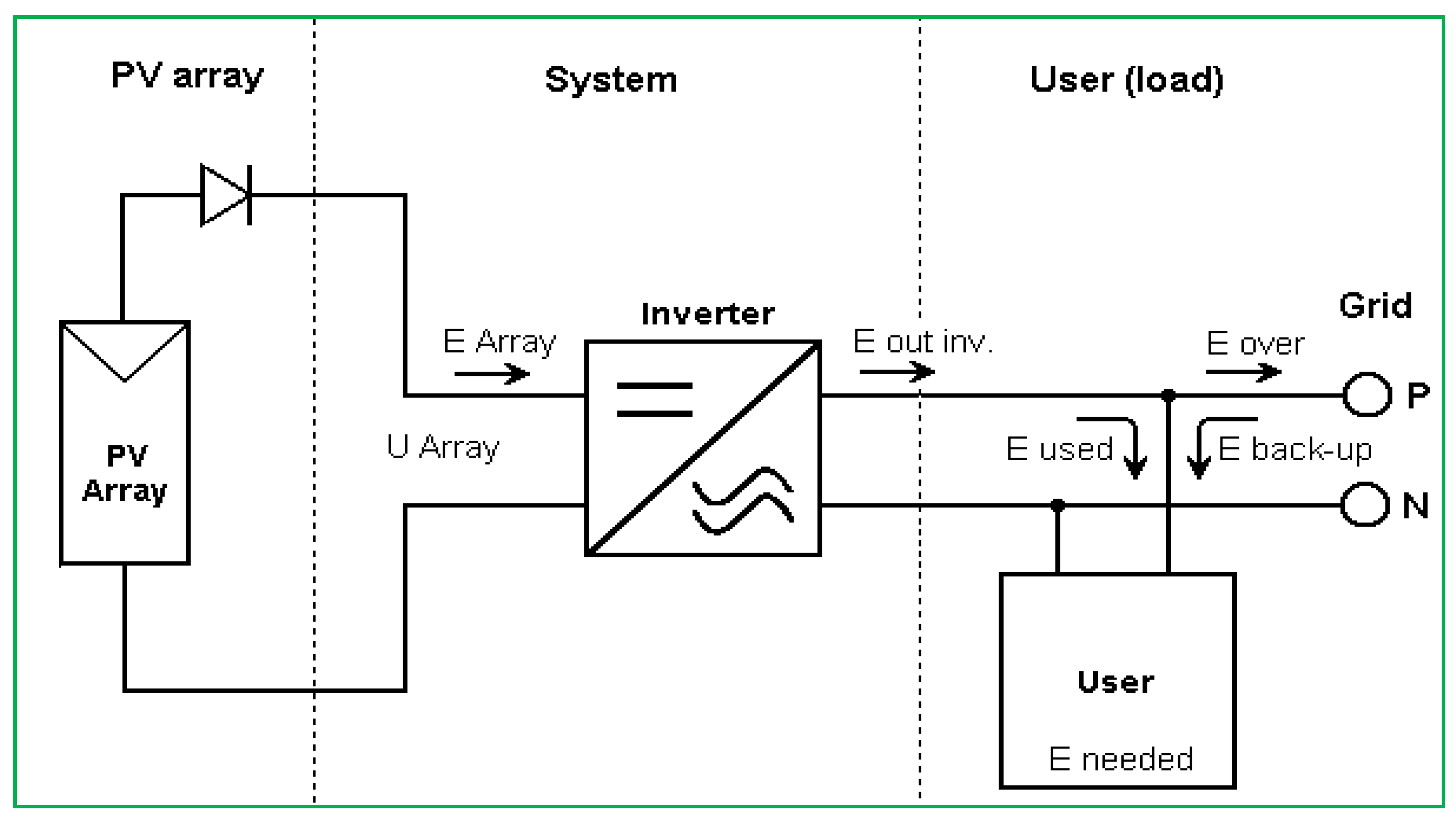
Figure 8.
Schematic diagram of the system.

3.2. System Configuration
The proposed plant is a grid-connected system in which no 3D scene is defined and no shadings are considered. The system power is 1874 kWp.
3.2.1. PV Field Orientation
The field type of the PV module and array is fixed plane. The plane tilt and azimuth of the field array are 20° and 0°, respectively. For near shading, no shadings are considered, and no 3D scene is defined in PVsyst software for the rooftop of the house. The free horizon is considered for the simulation.

Figure 9.
PV field orientation.

3.2.2. PV Array and Inverter Characteristics
The used PV array was made by Eco Delta Power. Its model number, which was taken from the original PVsyst database, is ECO-300M-60. A single unit array has a nominal Power (Pnom) of 300 Wp. There are 6248 active PV modules. These 6248 modules are set up in 284 strings, with each string made up of 22 modules connected in series. After installation, there are 10227 m2 of total PV modules and 9110 m2 of cells. The nominal power in STC is 1874 kWp. The maximum power points of power (Pmpp), voltage (Vmpp), and current (Impp) for operating conditions at 50°C are 1689 kWp, 643 V, and 2627 A, respectively.

Figure 10.
Information of PV array and inverter.

Manufacturer of used inverter is Parker Hannifin. It’s model no. is 890GTS_1500 which is collected from original PVsyst database. Pnom of the inverter unit is 1500 KWac. Number of used inverter is 1. Operating voltage of the inverter is 500-1000 V. Pnom ratio is 1.25.
3.3. PV Field and Array Detailed Losses Parameter
| Thermal Loss factor | |
| Module temperature according to irradiance | |
| Uc (const) | 20.0 W/m²K |
| Uv (wind) | 0.0 W/m²K/m/s |
|
Ohmic Losses Series Diode Loss |
|
| Voltage drop | 0.7 V |
| Loss fraction | 0.1 % at STC |
| DC Wiring Losses | |
| Global array resistance | 4.1 mΩ |
| Loss fraction | 1.5 % at STC |
Figure 11.
Wiring layout - parallel strings.
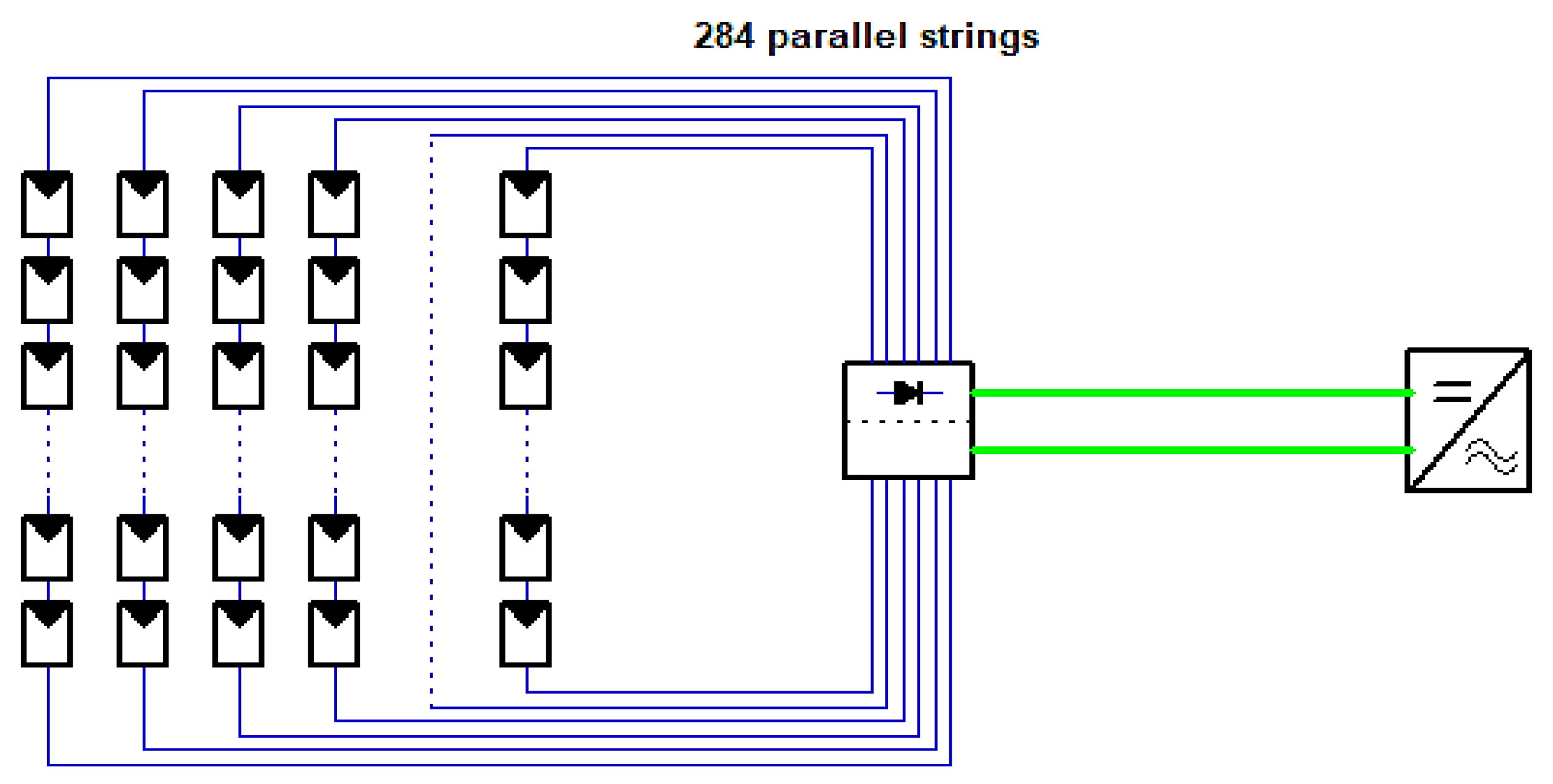
Figure 12.
Wiring layout – groups of parallel strings.
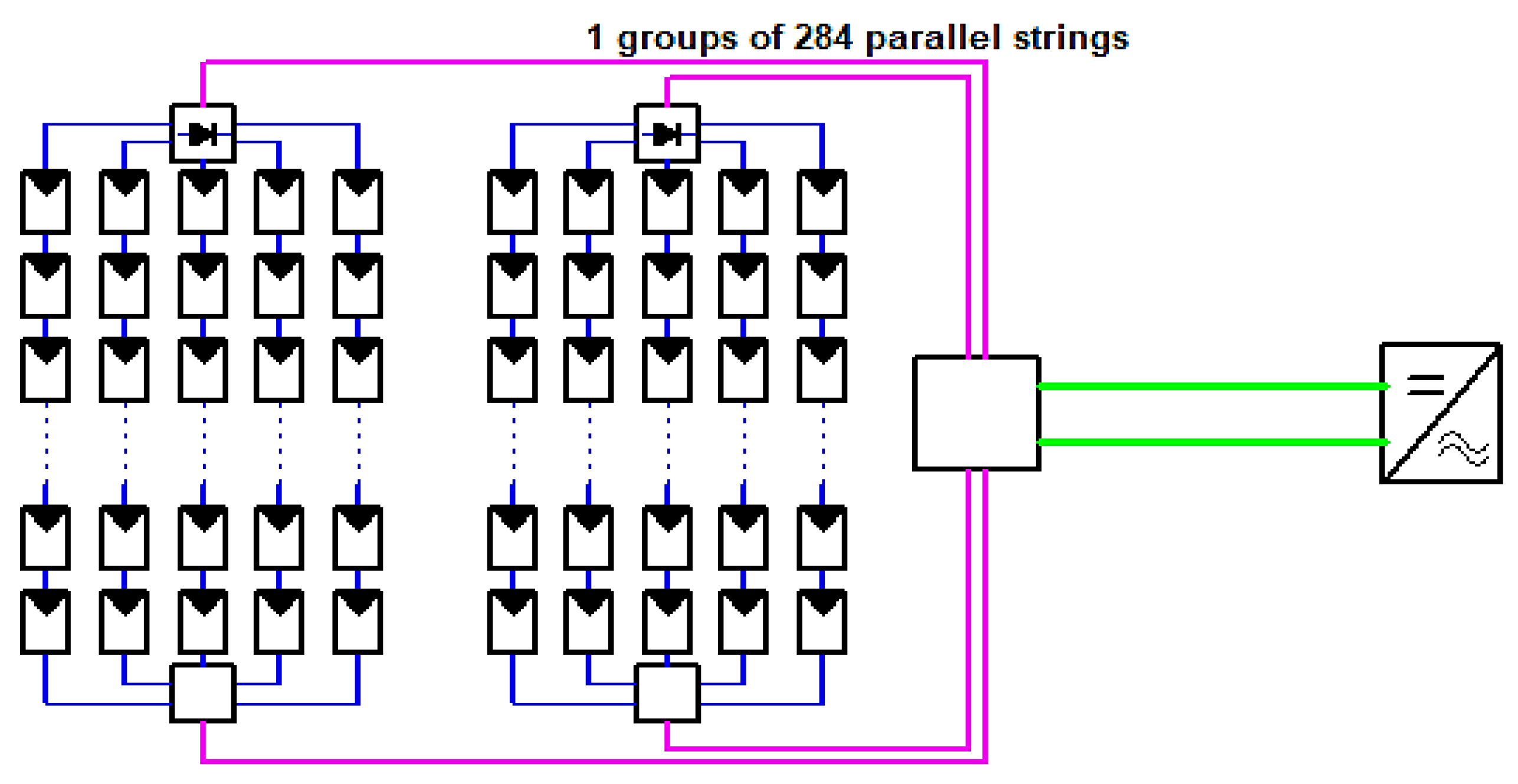
Table 1.
Different types of losses parameter.
|
Module Quality Loss Loss fraction |
-0.8 % |
|
LID - Light Induced Degradation Loss fraction |
2.0 % |
|
Module Mismatch Losses Loss fraction |
2.0 % at MPP |
|
Strings Mismatch loss Loss fraction |
0.1 % |
|
Array Soiling Losses Loss fraction |
3.0 % |
IAM Loss Factor
Incidence effect (IAM): Fresnel smooth glass, n = 1.526
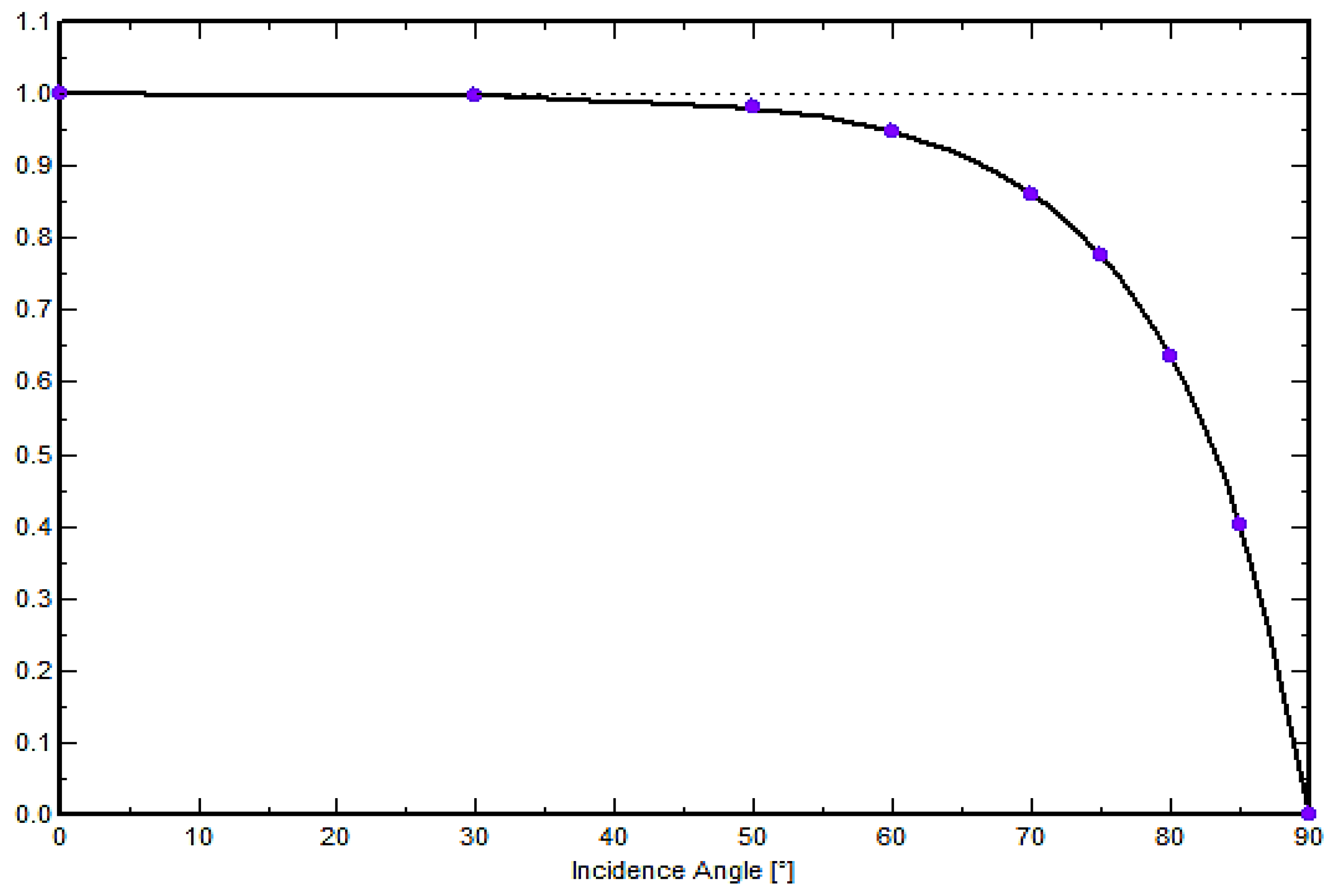
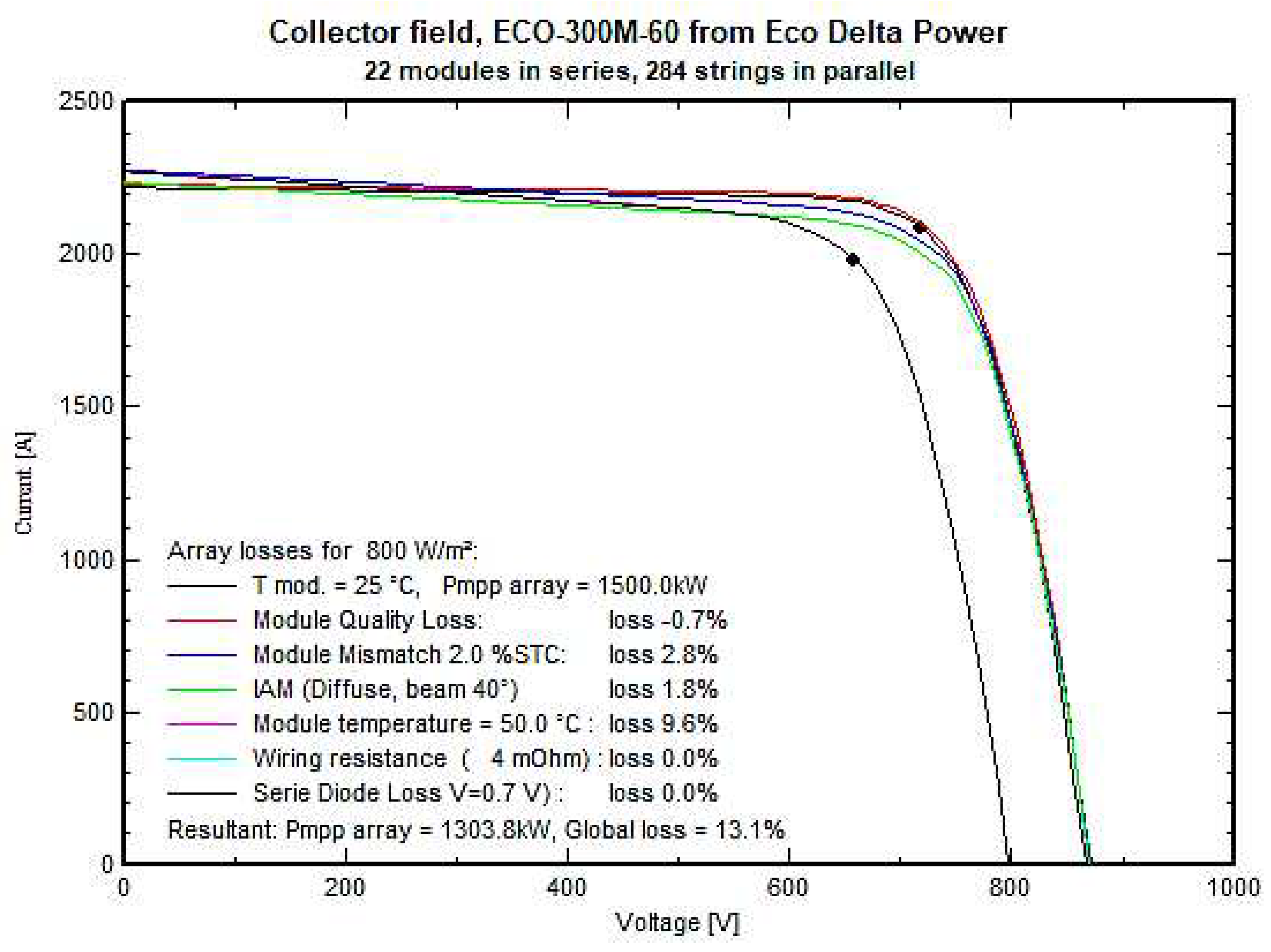
| 0° | 30° | 50° | 60° | 70° | 75° | 80° | 85° | 90° |
| 1.000 | 0.998 | 0.981 | 0.948 | 0.862 | 0.776 | 0.636 | 0.403 | 0.000 |
Figure 13.
Incidence angle modifier.

Figure 14.
PV array behaviour for each loss effect - losses graph.

3.4. Simulation Modeling
The annualized costs and discount factors from net present costs are calculated using the real discount rate. The variables “Nominal discount rate” and “Expected inflation rate” are used to generate the annual real discount rate, often known as the real interest rate or interest rate.
The following equation is used to get the real discount rate:
where:
real discount rate
nominal discount rate (the rate at which money could be borrowed)
expected inflation rate
An annuity, which is a stream of equal yearly cash payments, has a present value that is determined using a ratio called the capital recovery factor. The following equation is used to calculate the capital recovery factor:
where:
real discount rate
number of years
The present value of all of a system’s lifetime expenses minus the present value of all of its lifetime earnings equals the system’s total net present cost (NPC). Costs include up-front expenses, expenses for repairs and replacements, expenses for operations and maintenance, expenses for fuel, fines for pollution, and the cost of grid electricity. Salvage value as well as grid sales revenue are included in revenues.
The entire annualized cost is used to calculate the levelized cost of energy. The entire annualized cost is equal to the annualized value of the total net present cost. The following equation is used to determine the total annualized cost:
where:
CNPC, tot = the total net present cost [৳]
i = the annual real discount rate [%]
N = the project lifetime [year]
CRF (i, N) = a function returning the capital recovery factor
In order to calculate the COE, the program divides the annual cost of producing electricity (i.e., the total annual cost minus the cost of delivering the thermal load) by the total electric load serviced. The COE equation is:
where:
Cann,tot = total annualized cost of the system [taka/year]
Eserved = total electrical load served [kWh/year]
The following equation is used to determine the total annualized cost when total present cost is considered:
where:
Ctot = the total present cost [৳]
i = the annual real discount rate [%]
N = the project lifetime [year]
CRF (i, N) = a function returning the capital recovery factor
The software divides the annual cost of producing electricity (the total annual cost less the cost of serving the thermal demand) by the total amount of electrical energy produced to arrive at the LCOE. The equation for LCOE is:
where:
Cann,tot = total annualized cost of the system [taka/year]
Eg = total electrical energy generated [kWh/year]
4. Results and Discussion
The primary purposes of the PVsyst program are performance analysis and financial assessment of the solar facility. It supports pre-installation modeling by providing essential calculations, including space requirements, energy generation estimations based on allocated space, energy consumption calculations for auxiliary loads from both solar and the grid, injected energy estimations into the grid, and various loss calculations. In terms of financial analysis, the software furnishes data regarding total installation cost, operational expenses, cost of energy production, payback period, and the potential reduction in CO2 emissions.
4.1. Performance Analysis
The performance ratio measures how efficiently energy is produced or used in comparison to how much energy would be generated if the system were to run continuously at its nominal STC efficiency. The system’s performance ratio in this instance is 0.786, or 78.63 percent efficiency.

Figure 15.
Performance ratio (PR).

The normalized energy production in Figure 16 draws attention to three key figures: the PV array’s collection loss of 1.03 kWh/kWp/day, the system loss of 0.08 kWh/kWp/day, and the useable energy generated by the inverter output of 4.11 kWh/kWp/day. A solar power plant with a greater normalized energy production will, in contrast to one with a lower normalized energy production, produce more energy per kilowatt of installed capacity. Consequently, a solar power plant demonstrating higher normalized energy production proves to be more productive and cost-effective in its operations.
Figure 17 depicts the relationship between the worldwide incident irradiance on the collector plane (measured in kWh/m2/day) and the available solar energy (measured in kWh/day). Daily input/output diagrams are what this illustration is known as. The daily input/output diagram in the PVsyst software is a graphic representation of how the energy generated by a solar power plant varies in response to the daily incident irradiance. This tool is invaluable for comprehending the plant’s performance and pinpointing areas with potential for enhancement. Ideally, the daily input/output diagram should exhibit a nearly linear trend, albeit with a slight curvature at higher irradiance levels attributed to temperature effects. Any deviation from this pattern, particularly at elevated irradiances, may signify overload conditions on certain days. Monitoring this diagram over time provides insights into the solar power plant’s performance. Changes in the diagram can help identify issues like reduced energy production or increased losses, enabling timely intervention and system optimization.
Figure 18, illustrating system output power distribution, presents the relationship between available solar energy in kW and available solar energy in kWh per bin (kWh/Bin). In PVsyst software, the system output power distribution graph offers a visual representation of how the power output of a solar power plant is distributed over a specific time span.
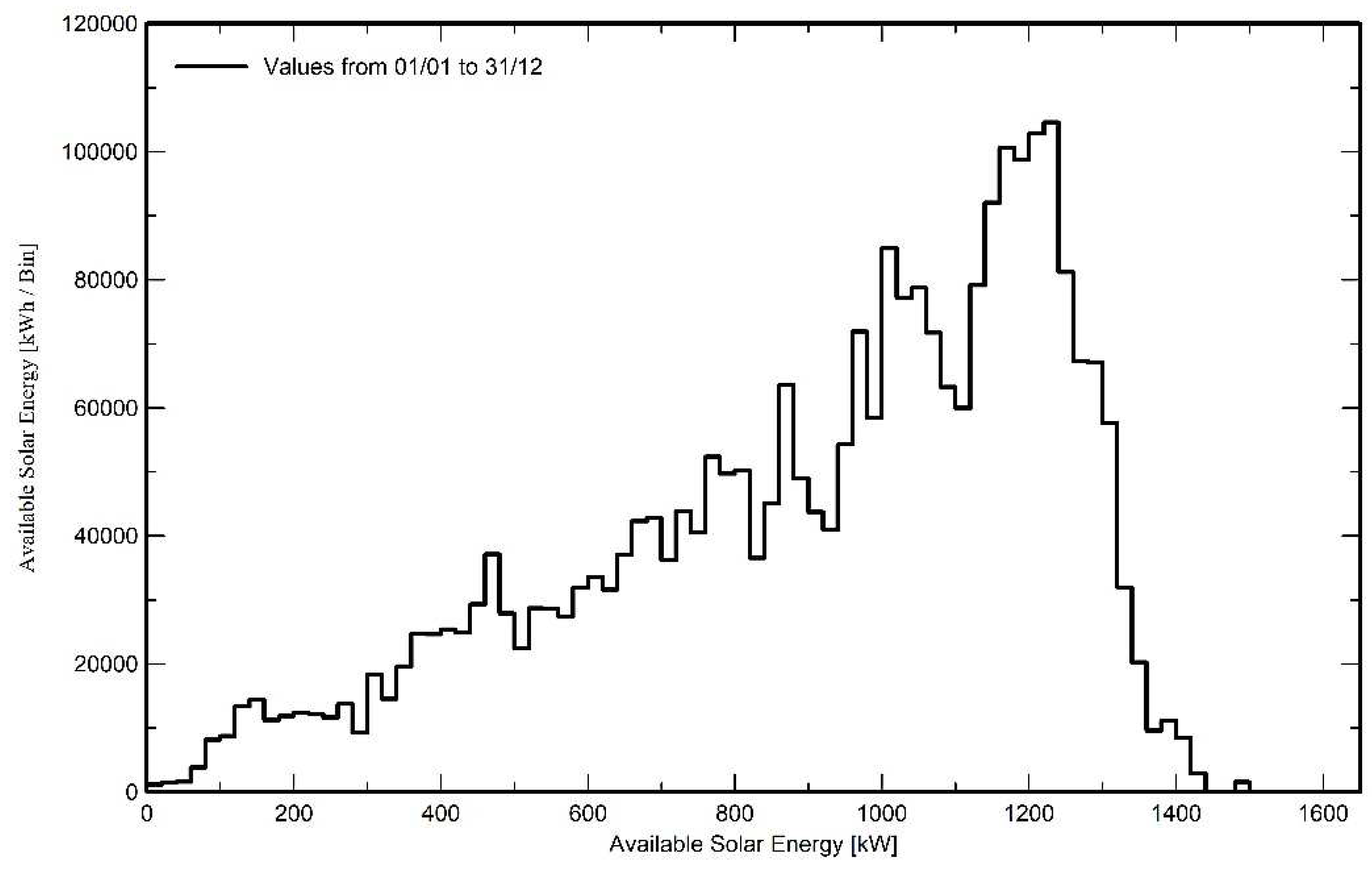
Figure 18.
System output power distribution.

Table 2.
Balances and main results.
| Month | GlobHor kWh/m2 |
DiffHor kWh/m2 |
T_Amb oC |
GlobInc kWh/m2 |
GlobEff kWh/m2 |
EArray MWh |
E_User MWh |
E_Solar MWh |
E_Grid MWh |
EFrGrid MWh |
|---|---|---|---|---|---|---|---|---|---|---|
| January | 122.3 | 54.1 | 17.35 | 153.7 | 145.6 | 240.7 | 7.440 | 3.069 | 232.8 | 4.371 |
| February | 132.6 | 60.3 | 21.49 | 155.8 | 147.7 | 237.9 | 6.720 | 3.025 | 230.2 | 3.695 |
| March | 174.6 | 78.3 | 26.48 | 191.0 | 180.9 | 283.4 | 7.440 | 3.479 | 274.4 | 3.961 |
| April | 182.5 | 88.7 | 29.10 | 185.4 | 175.2 | 271.9 | 7.200 | 3.547 | 263.1 | 3.653 |
| May | 190.0 | 100.7 | 30.27 | 182.4 | 171.9 | 267.5 | 7.440 | 3.701 | 258.6 | 3.739 |
| June | 155.3 | 99.9 | 29.46 | 146.0 | 137.0 | 217.5 | 7.200 | 3.706 | 209.3 | 3.494 |
| July | 145.1 | 99.2 | 29.24 | 137.4 | 128.6 | 206.0 | 7.440 | 3.770 | 197.9 | 3.670 |
| August | 145.8 | 90.6 | 28.99 | 143.0 | 134.2 | 213.7 | 7.440 | 3.692 | 205.5 | 3.748 |
| September | 139.4 | 74.2 | 27.91 | 145.8 | 137.2 | 216.8 | 7.200 | 3.485 | 208.8 | 3.715 |
| October | 136.0 | 72.5 | 26.95 | 152.6 | 144.5 | 229.4 | 7.440 | 3.382 | 221.3 | 4.058 |
| November | 127.8 | 54.0 | 23.13 | 158.3 | 150.0 | 241.5 | 7.200 | 2.959 | 233.9 | 4.241 |
| December | 122.7 | 50.2 | 18.73 | 158.7 | 150.3 | 246.6 | 7.440 | 3.035 | 238.7 | 4.405 |
| Year | 1774.2 | 922.8 | 25.77 | 1910.0 | 1803.1 | 2872.9 | 87.600 | 40.850 | 2774.4 | 46.750 |
Legends: GlobHor - Global horizontal irradiation, DiffHor - Horizontal diffuse irradiation, T_Amb - Ambient temperature, GlobInc - Global incident in coll. Plane, GlobEff - Effective Global, corr. for IAM and shadings, EArray - Effective energy at the output of the array, E_User - Energy supplied to the user, E_Solar - Energy from the sun, E_Grid - Energy injected into grid, EFrGrid - Energy from the grid.
4.2. Loss Diagram
The loss diagram functions as a visual representation in the form of a system loss flow chart. It serves by breaking down and illustrating the diverse factors contributing to energy losses within a solar installation. Each component, including shading, temperature, module quality, and inverter efficiency, is visually depicted on this diagram, providing users with a clear view of the relative impact of each factor on energy generation [36]. By inputting specific data such as geographical location, module specifications, and system design, users can generate a tailored loss diagram. This diagram proves to be an invaluable resource for solar professionals and engineers, aiding them in making well-informed decisions to optimize system design and operation. The ultimate goal is to maximize energy production and efficiency while minimizing losses [37]. As such, the loss diagram stands as a critical tool in the design and assessment of the viability of photovoltaic projects.
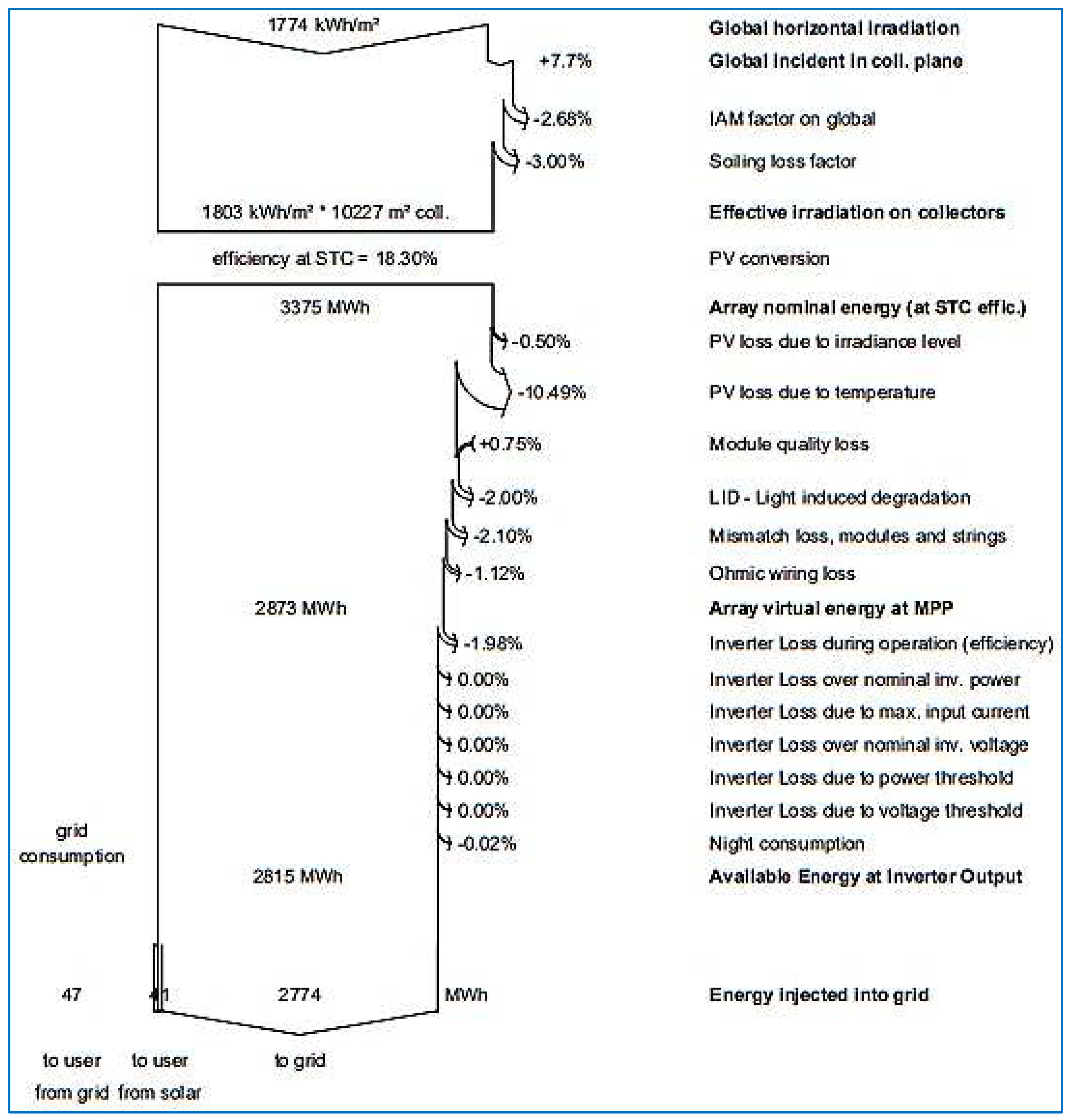
Figure 19.
Loss diagram.

4.3. P50 - P90 evaluation
| Meteo data | |
| Meteo data source | Meteonorm 7.3, Sat=100% |
| Kind | Not defined |
| Year-to-year variability (Variance) | 0.5 % |
| Specified Deviation | |
| Global variability (meteo + system) | |
| Variability (Quadratic sum) | 1.9 % |
| Simulation and parameters uncertainties | |
| PV module modelling/parameters | 1.0 % |
| Inverter efficiency uncertainty | 0.5 % |
| Soiling and mismatch uncertainties | 1.0 % |
| Degradation uncertainty | 1.0 % |
| Annual production probability | |
| Variability | 0.05 GWh |
| P50 | 2.77 GWh |
| P90 | 2.71 GWh |
| P95 | 2.69 GWh |
Figure 20.
Probability distribution.
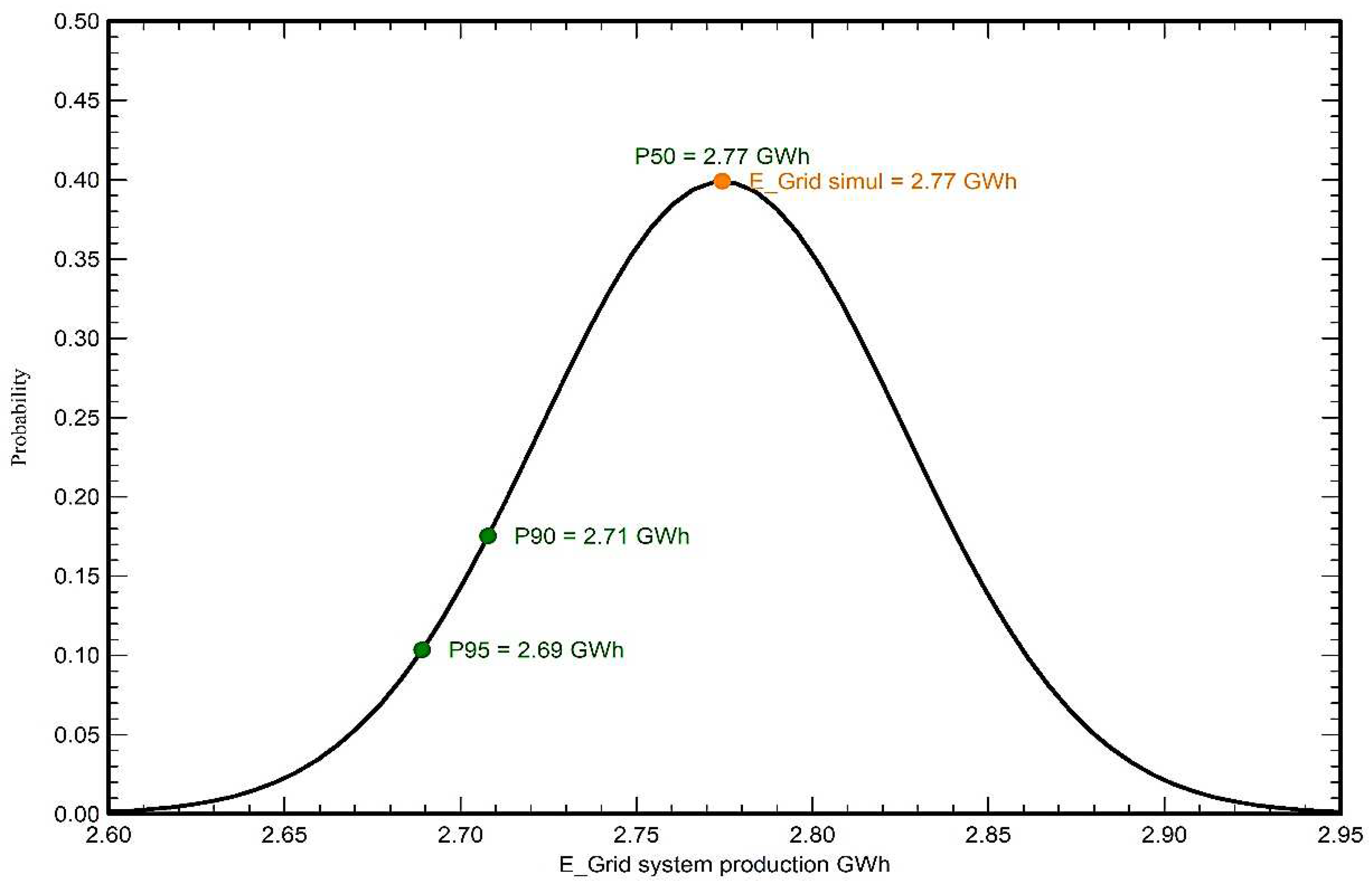
4.2. Financial Analysis
Table 3.
Installation costs.
| Item | Quantity units | Cost BDT |
Total BDT |
|---|---|---|---|
| PV modules ECO-300M-60 |
6248 | 12003.84 | 75000000.00 |
| Inverters 890GTS_1500 |
1 |
6000000.00 |
6000000.00 |
| Installation Settings |
1 |
10000000.00 |
10000000.00 |
| Total Depreciable asset |
91000000.0091000000.00 |
Table 4.
Operating costs.
| Item | Total BDT/year |
|---|---|
| Maintenance Cleaning |
50000.00 |
| Total (OPEX) Including inflation (2.00%) |
50000.00 64060.60 |
The plant’s net present value (NPV), or NPC, is calculated at 232,876,645 BDT. NPV represents the present value of all future cash flows related to the solar power plant, obtained by discounting future cash flows using an appropriate discount rate. Additionally, the ROI stands at a significant 671.7%, showcasing the return on investment as a percentage. It is derived by dividing the solar power plant’s net present value by the total project cost.
The gross income of 27,744 BDT/year represents the anticipated revenue generated by the solar power plant through selling electricity to the grid annually. This calculation is based on the energy sold to the grid, which amounts to 2,774 MWh/year, and the selling price of energy to the grid, set at 10 BDT/kWh. The gross income is a crucial component of the solar power plant’s cashflow, showcasing the revenue it generates. Table 5 and Figure 21 present a comprehensive cashflow analysis of the solar power plant. This cashflow analysis encapsulates all revenues and expenses associated with the solar power plant throughout its operational lifespan. It provides a detailed overview of the financial dynamics, incorporating the gross income generated from selling electricity to the grid. The representation of gross income as a positive cash flow emphasizes its role as a revenue stream for the solar power plant.
Figure 22 visually presents the cumulative cashflow of the solar power plant. This cumulative cashflow is derived by aggregating the annual cash flows throughout the predefined 25-year project lifespan. By summing up the annual cash flows, we obtain a clear depiction of how the solar power plant’s overall financial performance is anticipated to evolve over the years. The cumulative cashflow serves as a critical metric for assessing the solar power plant’s financial trajectory across its entire operational duration. It provides valuable insights into the financial dynamics and the cumulative impact of revenue generation and expenditure over time. The calculation of the cumulative cashflow is conducted using the specified equation, allowing for a comprehensive evaluation of the solar power plant’s financial sustainability and profitability throughout its projected operational period.
where annual cashflows are the cash flows associated with the solar power plant in each year of its lifetime. Figure 22 shows that the cumulative cashflow of the solar power plant is expected to be positive over its lifetime. This means that the solar power plant is expected to generate more revenue than it incurs in expenses. The cumulative cashflow graph is a useful tool for evaluating the financial performance of the solar power plant over its lifetime.
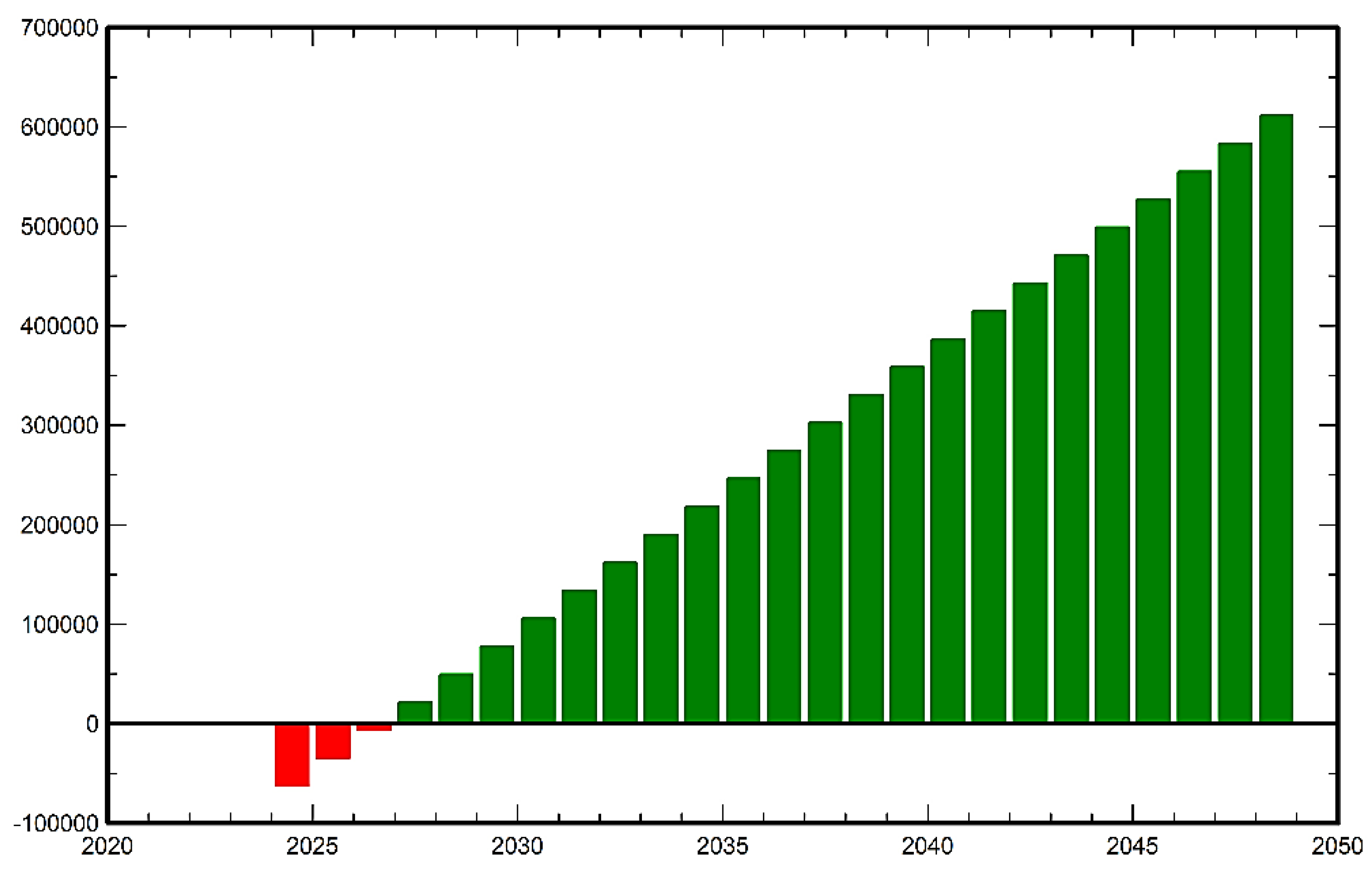
Cumulative cashflow = SUM (Annual cashflows)
Figure 22.
Cumulative cashflow (kBDT).

Table 6.
Analysis of return on investment (ROI) based on fixed feed-in tariff.
| Electricity sale Fixed feed-in tariff (BDT/kWh) |
Net present value (NPV) (BDT) |
Payback period (Years) |
Return on investment (ROI) (%) |
|---|---|---|---|
| 5.00 | 72950859 | 6.4 | 290.6 |
| 10.00 | 232876645 | 3.2 | 671.7 |
| 15.00 | 392802431 | 2.2 | 1052.8 |
4.3. Carbon Balance
The carbon balancing tool is essential in streamlining the computation of the expected decrease in CO2 emissions brought on by the installation of a PV system. The Life Cycle Emissions (LCE) concept, which includes all carbon dioxide emissions connected to a particular amount or kind of energy, is the foundation of this computation. These emissions are assessed throughout the component’s complete life cycle, including manufacturing, utilization, maintenance, and disposal, providing a comprehensive view [38].
By utilizing the carbon balance tool, we can determine that the PV system will effectively displace an equivalent amount of current grid power with electricity generated internally. This tool’s justification is that carbon dioxide emissions will be reduced overall if the carbon footprint of the PV system per kWh is lower than that of obtaining energy from the grid [39]. This presents a meaningful way to estimate and promote the positive environmental impact of transitioning to solar energy.
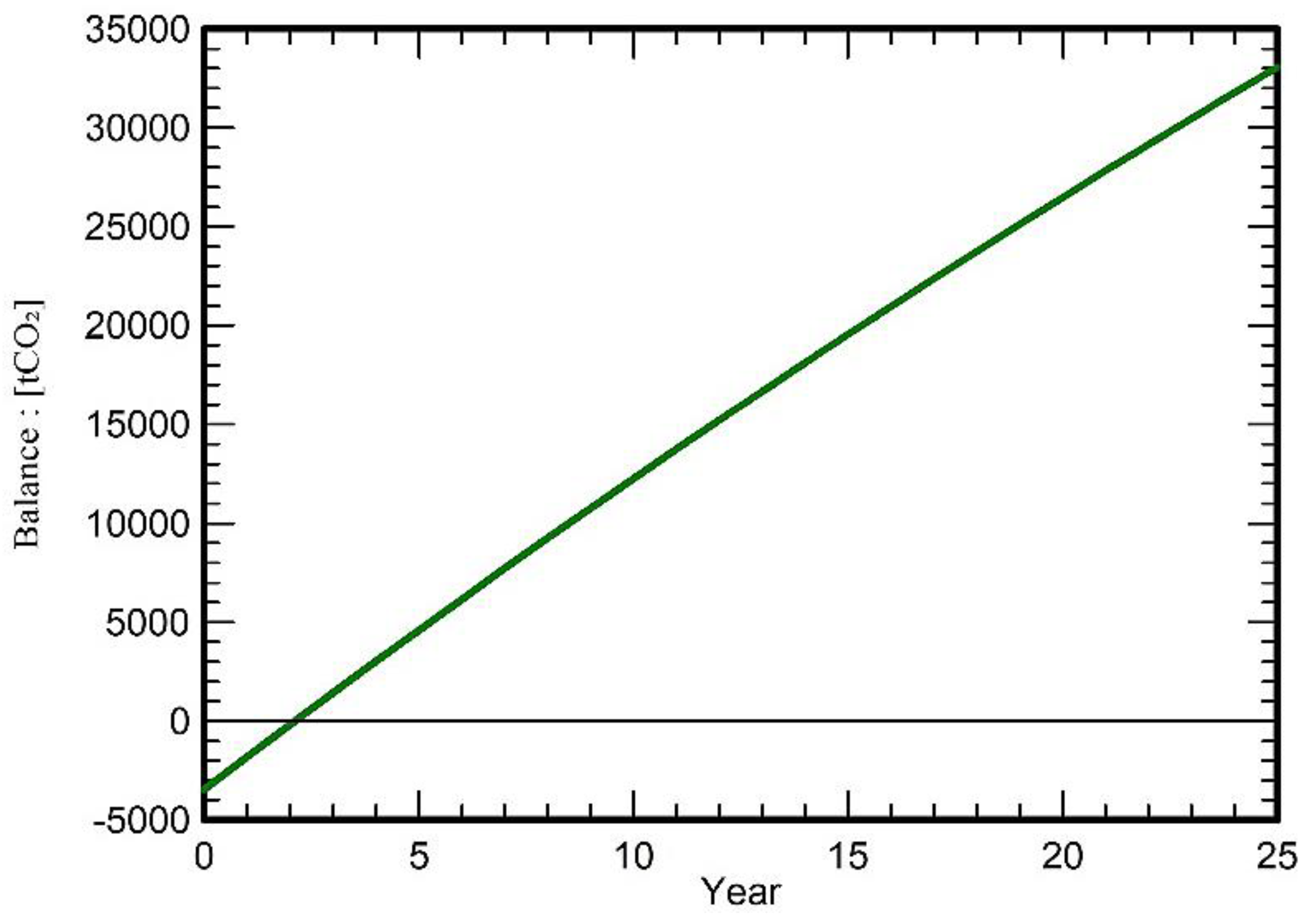
Figure 23.
Saved CO2 emission vs. time.

Therefore, the difference between generated and saved CO2 emissions is the total carbon balance for a PV plant.
which is the saved CO2 emissions over the project lifetime of 25 years.
Table 7.
System Lifecycle Emissions Details.
| Item | LCE | Quantity | Subtotal (kgCO2) |
|---|---|---|---|
| Modules | 1713 kgCO2/kWp | 1874 kWp | 3210322 |
| Supports | 3.90 kgCO2/kg | 62480 kg | 243377 |
| Inverters | 3.90 kgCO2/units | 1.00 unit | 386 |
| Total | 3454.085 |
Now, the carbon balance = (E_Grid × Project lifetime × LCE Grid) - LCE System
= (2815.2 MWh × 25 years × 584 gCO2) – 3454.1 tCO2
= 34074.061 tCO2
Table 8.
Comparison of different completed and running solar park projects and this proposed Char Jazira solar power plant in Bangladesh [40,41].
| SL. | Project Name | Capacity (MWp) |
Location | Latitude, Longitude | Agency | Expected Energy Generation and CO2 Emission Reduction During System Life | Expected Energy Generation and CO2 Emission Reduction till The Data Collection Day |
|---|---|---|---|---|---|---|---|
| 1 | 200 MW (AC) Solar Park by Beximco Power Co. Ltd. | 200 | Sundarganj, Gaibandha | 25.328795°N, 89.541671°E | BPDB | 4 TWh, 2 M tCO2 |
156 GWh, 74 k tCO2 |
| 2 | 30MW (AC) Solar Park by Intraco CNG Ltd. & Juli New Energy Co. Ltd. | 30 | Gangachara, Rangpur | 25.855312°N, 89.222482°E | BPDB | 654 GWh, 309 k tCO2 |
36 GWh, 17 k tCO2 |
| 3 | 100 MW (AC) Solar Park by Energon Technologies FZE & China Sunergy Co.Ltd (ESUN) | 100 | Mongla, Bagerhat | 22.650135°N, 89.761117°E | BPDB | 2 TWh, 1 M tCO2 |
199 GWh, 94 k tCO2 |
| 4 | Sirajganj 6.13 MW (AC) Grid Connected Solar Photovoltaic Power Plant | 7.6 | Sirajganj, Sirajgonj | 24.386177°N, 89.748409°E | NWPGCL | 166 GWh, 78 k tCO2 |
22 GWh, 10 k tCO2 |
| 5 | 35 MW AC Solar Park by Consortium of Spectra Engineers Limited & Shunfeng Investment Limited | 35 | Shibalaya, Manikganj | 23.848491°N, 89.913733°E | BPDB | 763 GWh, 361 k tCO2 |
102 GWh, 48 k tCO2 |
| 6 | 50 MW (AC) Solar Park by HETAT-DITROLIC-IFDC Solar Consortium | 50 | Gauripur, Mymensingh | 24.75894°N, 90.59746°E | BPDB | 1 TWh, 516 k tCO2 |
166 GWh, 79 k tCO2 |
| 7 | Kaptai 7.4 MWp (6.63 MW AC) Grid-connected Solar PV Power Plant | 7.4 | Kaptai, Rangamati | 22.493286°N, 92.218809°E | BPDB | 161 GWh, 76 k tCO2 |
37 GWh, 17 k tCO2 |
| 8 | 8 MW Solar Park by Parasol Energy Ltd. | 8 | Panchagarh, Panchagarh | 26.376098°N, 88.591665°E | BPDB | 174 GWh, 82 k tCO2 |
40 GWh, 19 k tCO2 |
| 9 | 20MW (AC) Solar Park by Joules Power Limited (JPL) | 20 | Teknaf, Cox’s Bazar | 20.980463°N, 92.252503°E | BPDB | 436 GWh, 206 k tCO2 |
116 GWh, 55 k tCO2 |
| 10 | 1.5 MW Grid-connected Solar Power Plant in Lalpur, Natore [Proposed] | 1.874 | Char Jazira, Lalpur, Natore |
24.0900°N, 88.5800°E |
Proposed |
70.375 GWh, 33074.061 tCO2 |
Proposed |
| Location | Generation Capacity (MW) | Project Status |
|---|---|---|
| Gangachara, Rangpura | 30 | aOngoing |
| Dharmapasha, Sunamganja | 32 | aOngoing |
| Gauripur, Mymensingha | 50 | aOngoing |
| Chuadangaa | 50 | aFuture |
| Netrokonaa | 50 | aFuture |
| Mongla, Bagerhata | 100 | aOngoing |
| Fenia | 100 | aFuture |
| Narsingdia | 120 | aFuture |
| Sundarganj, Gaibandhaa | 200 | aOngoing |
5. Conclusion
The escalating consumption of fossil fuels and surging consumer demand have led to frequent occurrences of load shedding. To combat this issue and ensure a continuous supply of electricity, solar energy stands as a promising solution. In this study, we explored the potential of solar energy generation, focusing on addressing the power deficit and reducing reliance on conventional energy sources. The annual solar energy availability of 3375 MWh emphasizes the substantial capacity of solar power. The inverter’s annual output of 2815 MWh signifies its ability to generate a significant amount of electricity annually. However, the overall system’s reduced power capacity of 560 MWh/year is attributed to diverse losses encountered in the system. Despite this, a notable portion of solar energy, 2774 MWh/year, is successfully integrated into the grid.
An analysis of performance ratios revealed seasonal variations, with the highest PR of 82% in January and the lowest of 77% in April. The yearly average PR of 78.63% indicates the system’s consistent performance and efficiency. Additionally, the solar fraction (SF) of 46.63% underlines the substantial contribution of solar energy in meeting electricity demands. The LCOE at 2.82 BDT per unit demonstrates the economic viability and cost-effectiveness of this solar PV system. A reasonable specific cost per KWp of 48.53 BDT during the investment phase further supports the financial feasibility of the solar project.
Over the plant’s projected 25-year lifespan, the expected energy generation of 70.375 GWh showcases the long-term benefits of solar energy. Remarkably, the calculated payback period of 3 years, 2 months, and 13 days emphasizes the rapid return on investment, highlighting the economic advantages of this sustainable energy solution. The significant environmental impact is a crucial aspect, with an impressive reduction of 33074.061 tCO2 emissions over the 25-year lifespan, reflecting the positive contribution of solar energy in reducing carbon footprints and promoting environmental sustainability. In conclusion, this solar technology proves to be a green and clean energy source, making substantial strides toward a more sustainable and eco-friendly future.
Author Contributions
Conceptualization, M.F.A. and N.K.S.; methodology, N.K.S.; software, M.F.A., N.K.S., A.H.S. and S.I.S.; validation, M.F.A., M.A.H. and S.A.; formal analysis, M.F.A.; investigation, N.K.S., A.H.S. and S.I.S.; resources, N.K.S.; data curation, N.K.S., A.H.S.; writing—original draft preparation, N.K.S., A.H.S. and M.F.A.; writing—review and editing, M.F.A., A.H.S. and M.A.H.; visualization, M.F.A. and N.K.S.; supervision, M.F.A.; project administration, M.F.A.; funding acquisition, M.F.A., M.A.H. and S.A. All authors have read and agreed to the published version of the manuscript.
Funding
This work is supported by Pabna University of Science and Technology (PUST) under the research grant in the fiscal year 2023-2024.
Data Availability Statement
The authors confirm that the data supporting the findings of this study are available within the article.
Acknowledgments
Thanks to Pabna University of Science and Technology (PUST) for the research funding. Also, thanks to Department of Electrical and Electronic Engineering (EEE), Pabna University of Science and Technology (PUST) for the renewable energy lab.
Conflicts of Interest
The authors declare no conflict of interest.
List of Abbreviations and Symbols
| Abbreviation/Symbol | Elaboration/Meaning |
| ৳ | Taka (BDT) |
| ° | Degree |
| °C | Degree Celsius |
| A | Ampere |
| AC | Alternating Current |
| Ah | Ampere hour |
| BDT | Bangladeshi Taka |
| BPDB | Bangladesh Power Development Board |
| CO2 | carbon dioxide |
| COE | Cost of Energy |
| CRF | Capital Recovery Factor |
| DC | Direct Current |
| DHI | Diffuse Horizontal Irradiance |
| DNI | Direct Normal Irradiance |
| gCO2 | gram carbon dioxide |
| GHI | Global Horizontal Irradiance |
| GIS | Geographical Information System |
| GW | gigawatt |
| GWh | Gigawatt hour |
| IAM | Incidence Angle Modifier |
| Impp | Current at Maximum Power Point |
| IRR | Internal Rate of Return |
| kW | kilowatt |
| kWac | kilowatt alternating current |
| kWdc | kilowatt direct current |
| kWh | kilowatt hour |
| kWp | kilowatt peak |
| LCE | Life Cycle Emissions |
| LCOE | Levelized Cost of Energy |
| MWh | Megawatt hour |
| mΩ | Milliohm |
| NPC | Net Present Cost |
| NPV | Net Present Value |
| NWPGL | North-West Power Generation Company Ltd. |
| O&M | Operation and Maintenance |
| OPEX | Operation Expenditure |
| Pmpp | Power at Maximum Power Point |
| Pnom | Nominal Power |
| PR | Performance Ratio |
| PV | Photovoltaic |
| RH | Relative humidity |
| ROI | Return on Investment |
| SF | Solar Fraction |
| STC | Standard Test Condition |
| tCO2 | ton carbon dioxide |
| V | volt |
| Vmpp | Voltage at Maximum Power Point |
| W | watt |
| Wh | watt hour |
References
- Solar Energy In Bangladesh: Current Status and Future. Available online: https://energytracker.asia/solar-energy-in-bangladesh-current-status-and-future/?fbclid=IwAR2dpVoe0scUzqZ_VGKQm2M3jkzN0UawrjmlbM3h9i0F_wGdD874jBmZUzg (accessed on 4 September 2023).
- Islam, M.S. Feasibility Analysis and Simulation of the Solar Photovoltaic Rooftop System Using PVsyst Software. Int. J. Educ. Manag. Eng. 2022, 12, 21–32. [Google Scholar] [CrossRef]
- Omar, M.A.; Mahmoud, M.M. Economic Evaluation of Residential Grid Connected PV Systems Based on Net- Metering and Feed-in- Tariff Schemes in Palestine. Int. J. Renew. Energy Res. 2018, 8, 2106–2115. [Google Scholar] [CrossRef]
- Podder, A.K.; Das, A.K.; Hossain, E.; Kumar, N.M.; Roy, N.K.; Alhelou, H.H.; Karthick, A.; Al-Hinai, A. Integrated Modeling and Feasibility Analysis of a Rooftop Photovoltaic Systems for an Academic Building in Bangladesh. Int. J. Low-Carbon Technol. 2021, 16, 1317–1327. [Google Scholar] [CrossRef]
- Hasan, M.; Tanvir, A.A.; Siddiquee, S.M.S.; Zubair, A. Efficient Hybrid Renewable Energy System for Industrial Sector with On-Grid Time Management. 2015 Int. Conf. Green Energy Technol. ICGET 2015 2015, 4–9. [Google Scholar] [CrossRef]
- Duman, A.C.; Güler, Ö. Economic Analysis of Grid-Connected Residential Rooftop PV Systems in Turkey. Renew. Energy 2020, 148, 697–711. [Google Scholar] [CrossRef]
- Ihsan, M.A.; Eram, A.F.; Khadem, M.M. Viability Study of Net Metering Scheme in Residential Scale: A Bangladeshi Perspective. Proc. Int. Conf. Comput. Intell. Sustain. Eng. Solut. CISES 2022 2022, 361–365. [Google Scholar] [CrossRef]
- Poudyal, R.; Loskot, P.; Parajuli, R. Techno-Economic Feasibility Analysis of a 3-KW PV System Installation in Nepal. Renewables Wind. Water, Sol. 2021, 8. [Google Scholar] [CrossRef]
- Imam, A.A.; Al-Turki, Y.A.; Sreerama Kumar, R. Techno-Economic Feasibility Assessment of Grid-Connected PV Systems for Residential Buildings in Saudi Arabia-A Case Study. Sustain. 2020, 12. [Google Scholar] [CrossRef]
- Faiz, F.U.H.; Shakoor, R.; Raheem, A.; Umer, F.; Rasheed, N.; Farhan, M. Modeling and Analysis of 3 MW Solar Photovoltaic Plant Using PVSyst at Islamia University of Bahawalpur, Pakistan. Int. J. Photoenergy 2021, 2021. [Google Scholar] [CrossRef]
- Baqir, M.; Channi, H.K. Analysis and Design of Solar PV System Using Pvsyst Software. Mater. Today Proc. 2022, 48, 1332–1338. [Google Scholar] [CrossRef]
- Kumar, R.; Rajoria, C.S.; Sharma, A.; Suhag, S. Design and Simulation of Standalone Solar PV System Using PVsyst Software: A Case Study. Mater. Today Proc. 2020, 46, 5322–5328. [Google Scholar] [CrossRef]
- Satish, M.; Santhosh, S.; Yadav, A. Simulation of a Dubai Based 200 KW Power Plant Using PVsyst Software. 2020 7th Int. Conf. Signal Process. Integr. Networks, SPIN 2020 2020, 824–827. [Google Scholar] [CrossRef]
- Jagadale, P.; Choudhari, A.; Jadhav, S. Design and Simulation of Grid Connected Solar Si-Poly Photovoltaic Plant Using PVsyst For Pune, India Location. Renew. Energy Res. Appl. 2022, 3, 41–49. [Google Scholar]
- Grover, A.; Khosla, A.; Joshi, D. Design and Simulation of 20MW Photovoltaic Power Plant Using PVSyst. Indones. J. Electr. Eng. Comput. Sci. 2020, 19, 58–65. [Google Scholar] [CrossRef]
- Chauhan, A.; Sharma, M.; Baghel, S. Designing and Performance Analysis of 15KWP Grid Connection Photovoltaic System Using Pvsyst Software. Proc. 2nd Int. Conf. Inven. Res. Comput. Appl. ICIRCA 2020 2020, 1003–1008. [Google Scholar] [CrossRef]
- Kapoor, S.; Sharma, A.K.; Porwal, D. Design and Simulation of 60kWp Solar On-Grid System for Rural Area in Uttar-Pradesh by “PVsyst. ” J. Phys. Conf. Ser. 2021, 2070. [Google Scholar] [CrossRef]
- Belmahdi, B.; El Bouardi, A. Solar Potential Assessment Using PVsyst Software in the Northern Zone of Morocco. Procedia Manuf. 2020, 46, 738–745. [Google Scholar] [CrossRef]
- Tamoor, M.; Bhatti, A.R.; Farhan, M.; Miran, S.; Raza, F.; Zaka, M.A. Designing of a Hybrid Photovoltaic Structure for an Energy-Efficient Street Lightning System Using PVsyst Software †. Eng. Proc. 2021, 12, 10–14. [Google Scholar] [CrossRef]
- Mohammadi, S.A.D.; Gezegin, C. Design and Simulation of Grid-Connected Solar PV System Using PVSYST, PVGIS and HOMER Software. Int. J. Pioneer. Technol. Eng. 2022, 1, 36–41. [Google Scholar] [CrossRef]
- PVsyst – Logiciel Photovoltaïque. Available online: https://www.pvsyst.com/ (accessed on 1 September 2023).
- Dalala, S.; B, V.J.; Rautc, R. Mr Swapnil Narkhede SSRN ANALYSIS OF 1KW SOLAR ROOFTOP SYSTEM BY USING PVSyst. Int. Conf. Commun. Inf. Process. 2020, 1–8. [Google Scholar]
- Solar Panel Orientation - Energy Education. Available online: https://energyeducation.ca/encyclopedia/Solar_panel_orientation (accessed on 1 September 2023).
- Tilt and Orientation and Solar Energy. Available online: https://www.viridiansolar.co.uk/resources-1-3-tilt-and-orientation.html (accessed on 1 September 2023).
- Bansal, N.; Pany, P.; Singh, G. Visual Degradation and Performance Evaluation of Utility Scale Solar Photovoltaic Power Plant in Hot and Dry Climate in Western India. Case Stud. Therm. Eng. 2021, 26, 101010. [Google Scholar] [CrossRef]
- Talavera, D.L.; Muñoz-Cerón, E.; de la Casa, J.; Lozano-Arjona, D.; Theristis, M.; Pérez-Higueras, P.J. Complete Procedure for the Economic, Financial and Cost-Competitiveness of Photovoltaic Systems with Self-Consumption. Energies 2019, 12, 1–23. [Google Scholar] [CrossRef]
- Cui, Y.; Zhu, J.; Meng, F.; Zoras, S.; McKechnie, J.; Chu, J. Energy Assessment and Economic Sensitivity Analysis of a Grid-Connected Photovoltaic System. Renew. Energy 2020, 150, 101–115. [Google Scholar] [CrossRef]
- Meteo Database > Import Meteo Data > Meteonorm Data and Program. Available online: https://www.pvsyst.com/help/meteo_source_meteonorm.htm (accessed on 1 September 2023).
- Intro - Meteonorm (En). Available online: https://meteonorm.meteotest.ch/en/ (accessed on 1 September 2023).
- Surface Meteorology and Solar Energy (SSE) Data Release 5.1 - NASA Technical Reports Server (NTRS). Available online: https://ntrs.nasa.gov/citations/20080012141 (accessed on 1 September 2023).
- Solar Resource Maps and GIS Data for 200+ Countries | Solargis. Available online: https://solargis.com/maps-and-gis-data/download/bangladesh (accessed on 1 September 2023).
- Eltbaakh, Y.A.; Ruslan, M.H.; Alghoul, M.A.; Othman, M.Y.; Sopian, K.; Razykov, T.M. Solar Attenuation by Aerosols: An Overview. Renew. Sustain. Energy Rev. 2012, 16, 4264–4276. [Google Scholar] [CrossRef]
- Page, J.K. RADIATION DATA. 1981, 23–35. [Google Scholar] [CrossRef]
- Bowen, A. FUNDAMENTALS OF SOLAR ARCHITECTURE. Sol. Energy Convers. 1979, 481–553. [Google Scholar] [CrossRef]
- Yousef, B.A.A.; Radwan, A.; Olabi, A.G.; Abdelkareem, M.A. Sun Composition, Solar Angles, and Estimation of Solar Radiation. Renew. Energy - Vol. 1 Solar, Wind. Hydropower Defin. Dev. Appl. Case Stud. Model. Simul. 2023, 1, 3–22. [Google Scholar] [CrossRef]
- Mermoud, A. Modeling Systems Losses in PVsyst. 2013, 1–15. [Google Scholar]
- Soualmia, A.; Chenni, R. Modeling and Simulation of 15MW Grid-Connected Photovoltaic System Using PVsyst Software. Proc. 2016 Int. Renew. Sustain. Energy Conf. IRSEC 2016 2017, 702–705. [Google Scholar] [CrossRef]
- What Is the Carbon Footprint of Solar Panels? | Solar.Com. Available online: https://www.solar.com/learn/what-is-the-carbon-footprint-of-solar-panels/ (accessed on 2 September 2023).
- Project Design > Carbon Balance Tool. Available online: https://www.pvsyst.com/help/carbon_balance_tool.htm (accessed on 2 September 2023).
- Solar Park | National Database of Renewable Energy, SREDA. Available online: http://www.renewableenergy.gov.bd/index.php?id=1&i=1&pg=1 (accessed on 4 September 2023).
- Sustainable and Renewable Energy Development Authority (SREDA)-Power Division; Ministry of Power, Energy & Mineral Resources. Available online: http://www.sreda.gov.bd/ (accessed on 4 September 2023).
Figure 16.
Normalized productions (per installed kWp).
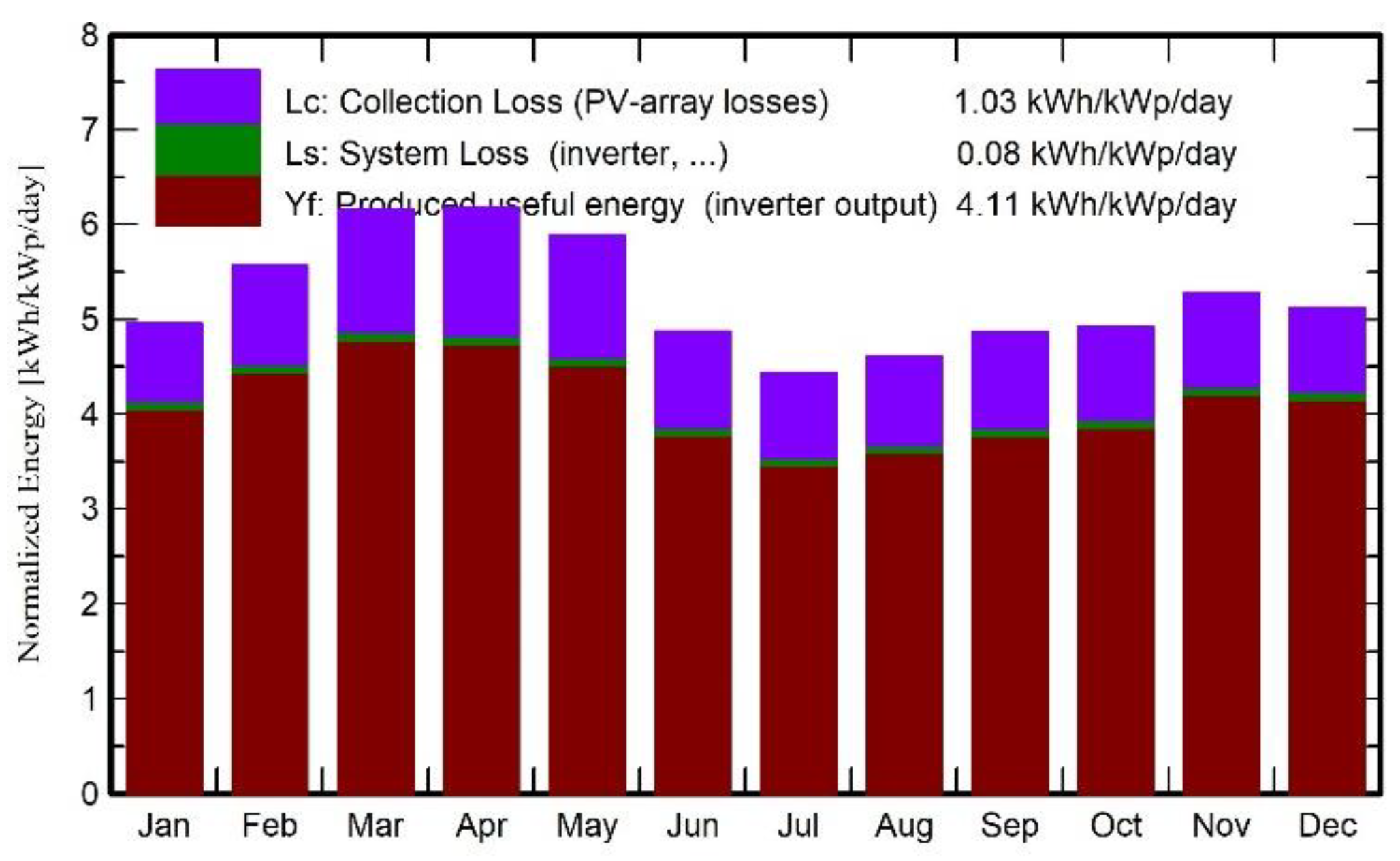
Figure 17.
Daily input/output diagram.
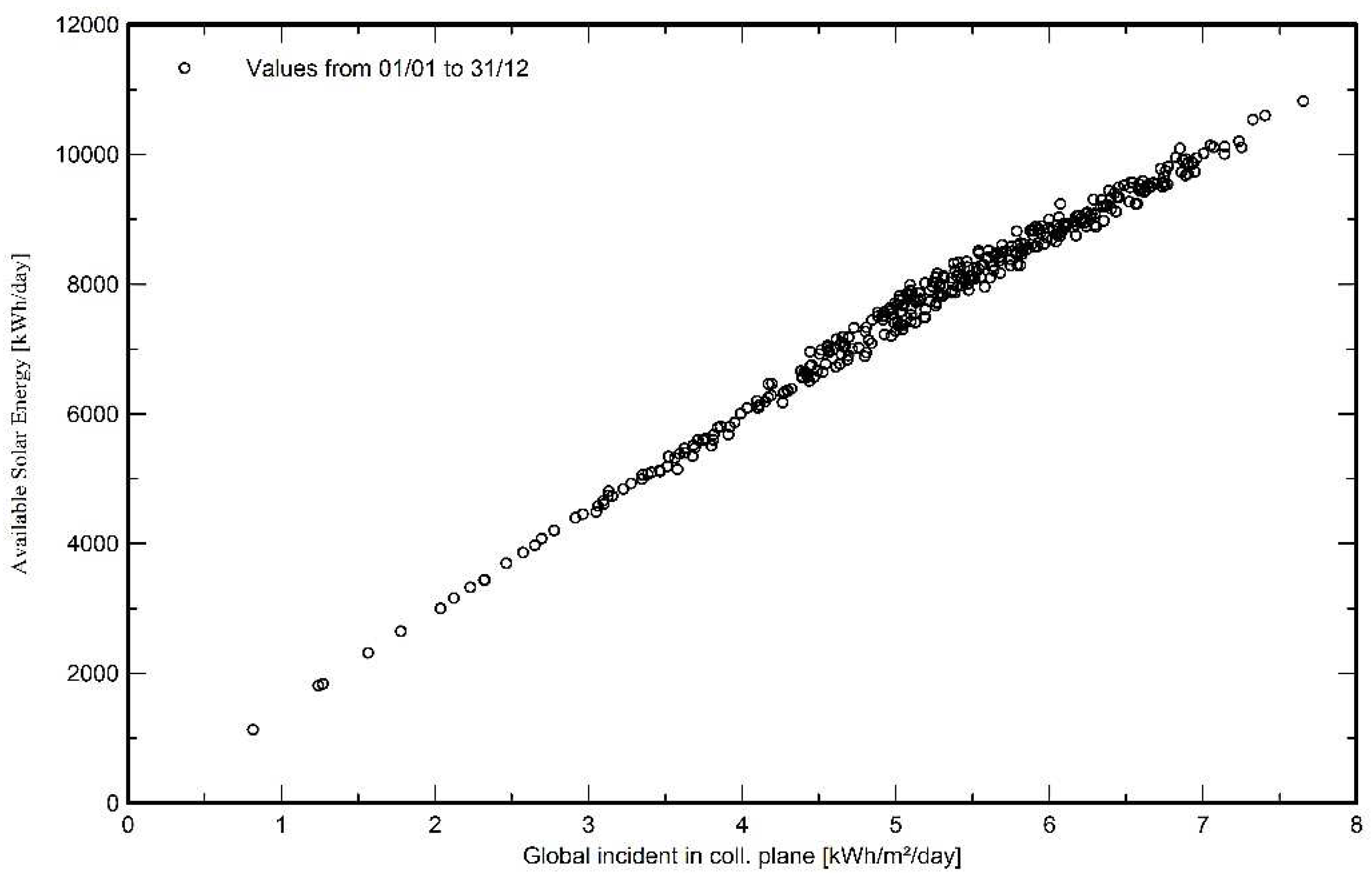
Figure 21.
Yearly net profit (kBDT).

Table 5.
Detailed economic results (BDT).
| Year | Gross income | Running costs | Depreciable allowance | Taxable income | Taxes | After-tax profit | Self- consumption saving |
Cumulative Profit |
% Amorti. |
|---|---|---|---|---|---|---|---|---|---|
| 2024 | 27744 | 50 | 0 | 27694 | 0 | 27694 | 408 | -62898 | 30.9% |
| 2025 | 27744 | 51 | 0 | 27693 | 0 | 27693 | 408 | -34796 | 61.8% |
| 2026 | 27744 | 52 | 0 | 27692 | 0 | 27692 | 408 | -6696 | 92.6% |
| 2027 | 27744 | 53 | 0 | 27691 | 0 | 27691 | 408 | 21403 | 123.5% |
| 2028 | 27744 | 54 | 0 | 27690 | 0 | 27690 | 408 | 49501 | 154.4% |
| 2029 | 27744 | 55 | 0 | 27689 | 0 | 27689 | 408 | 77598 | 185.3% |
| 2030 | 27744 | 56 | 0 | 27687 | 0 | 27687 | 408 | 105694 | 216.1% |
| 2031 | 27744 | 57 | 0 | 27686 | 0 | 27686 | 408 | 133789 | 247.0% |
| 2032 | 27744 | 59 | 0 | 27685 | 0 | 27685 | 408 | 161883 | 277.9% |
| 2033 | 27744 | 60 | 0 | 27684 | 0 | 27684 | 408 | 189975 | 308.8% |
| 2034 | 27744 | 61 | 0 | 27683 | 0 | 27683 | 408 | 218067 | 339.6% |
| 2035 | 27744 | 62 | 0 | 27682 | 0 | 27682 | 408 | 246157 | 370.5% |
| 2036 | 27744 | 63 | 0 | 27680 | 0 | 27680 | 408 | 274246 | 401.4% |
| 2037 | 27744 | 65 | 0 | 27679 | 0 | 27679 | 408 | 302333 | 432.2% |
| 2038 | 27744 | 66 | 0 | 27678 | 0 | 27678 | 408 | 330420 | 463.1% |
| 2039 | 27744 | 67 | 0 | 27677 | 0 | 27677 | 408 | 358505 | 494.0% |
| 2040 | 27744 | 69 | 0 | 27675 | 0 | 27675 | 408 | 386588 | 524.8% |
| 2041 | 27744 | 70 | 0 | 27674 | 0 | 27674 | 408 | 414671 | 555.7% |
| 2042 | 27744 | 71 | 0 | 27672 | 0 | 27672 | 408 | 442752 | 586.5% |
| 2043 | 27744 | 73 | 0 | 27671 | 0 | 27671 | 408 | 470831 | 617.4% |
| 2044 | 27744 | 74 | 0 | 27670 | 0 | 27670 | 408 | 498909 | 648.3% |
| 2045 | 27744 | 76 | 0 | 27668 | 0 | 27668 | 408 | 526986 | 679.1% |
| 2046 | 27744 | 77 | 0 | 27667 | 0 | 27667 | 408 | 555061 | 710.0% |
| 2047 | 27744 | 79 | 0 | 27665 | 0 | 27665 | 408 | 583134 | 740.8% |
| 2048 | 27744 | 80 | 0 | 27663 | 0 | 27663 | 408 | 611206 | 771.7% |
| Total | 693595 | 1602 | 0 | 691994 | 0 | 691994 | 10212 | 611206 | 771.7% |
Disclaimer/Publisher’s Note: The statements, opinions and data contained in all publications are solely those of the individual author(s) and contributor(s) and not of MDPI and/or the editor(s). MDPI and/or the editor(s) disclaim responsibility for any injury to people or property resulting from any ideas, methods, instructions or products referred to in the content. |
© 2023 by the authors. Licensee MDPI, Basel, Switzerland. This article is an open access article distributed under the terms and conditions of the Creative Commons Attribution (CC BY) license (http://creativecommons.org/licenses/by/4.0/).
Copyright: This open access article is published under a Creative Commons CC BY 4.0 license, which permit the free download, distribution, and reuse, provided that the author and preprint are cited in any reuse.
MDPI Initiatives
Important Links
© 2024 MDPI (Basel, Switzerland) unless otherwise stated











